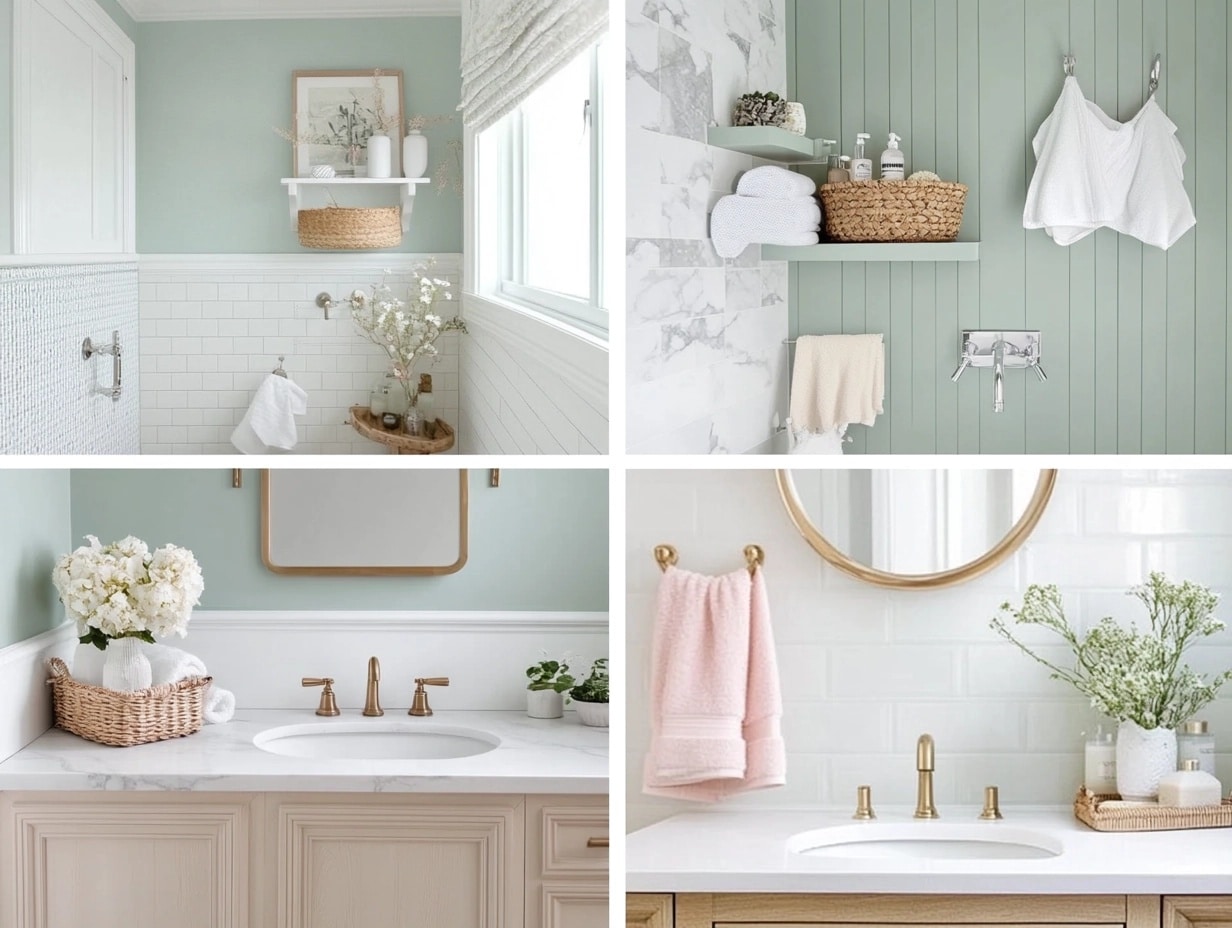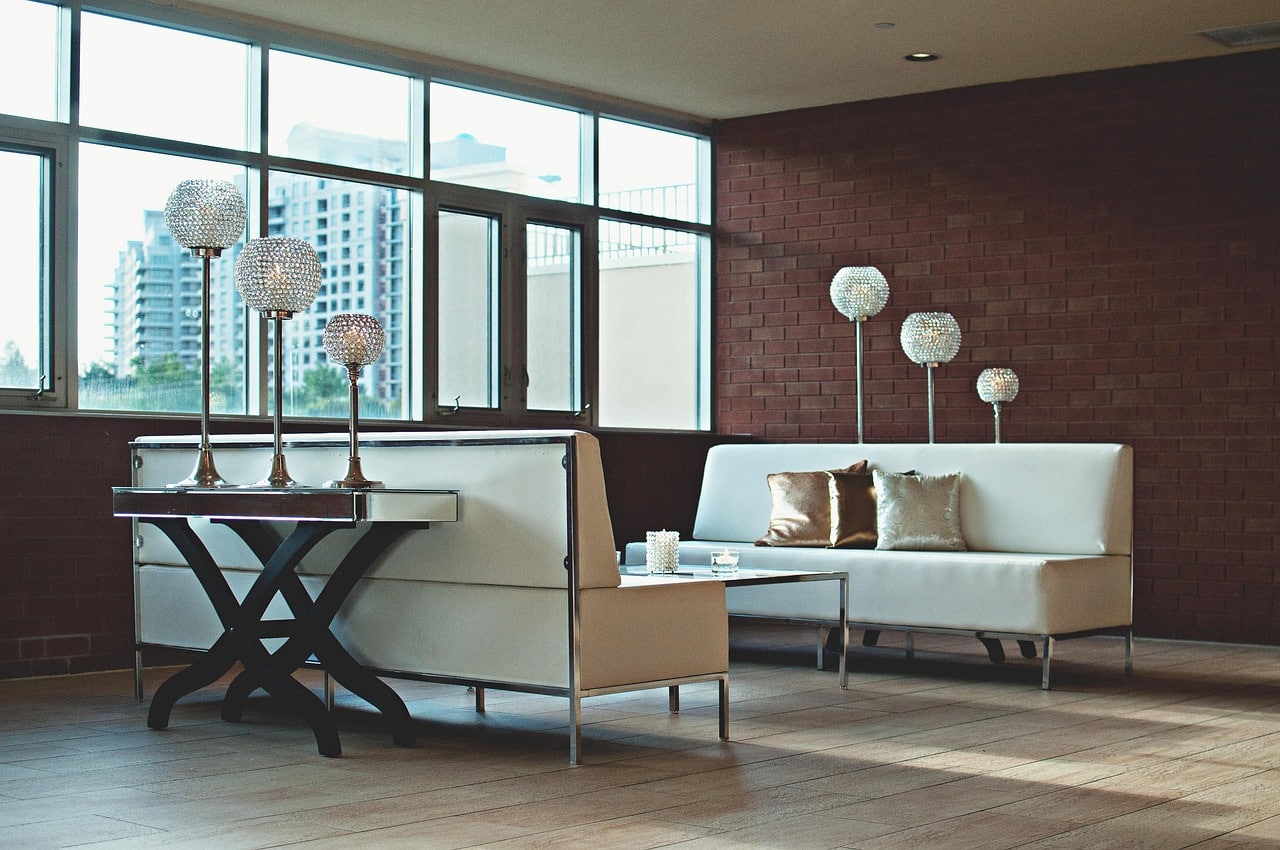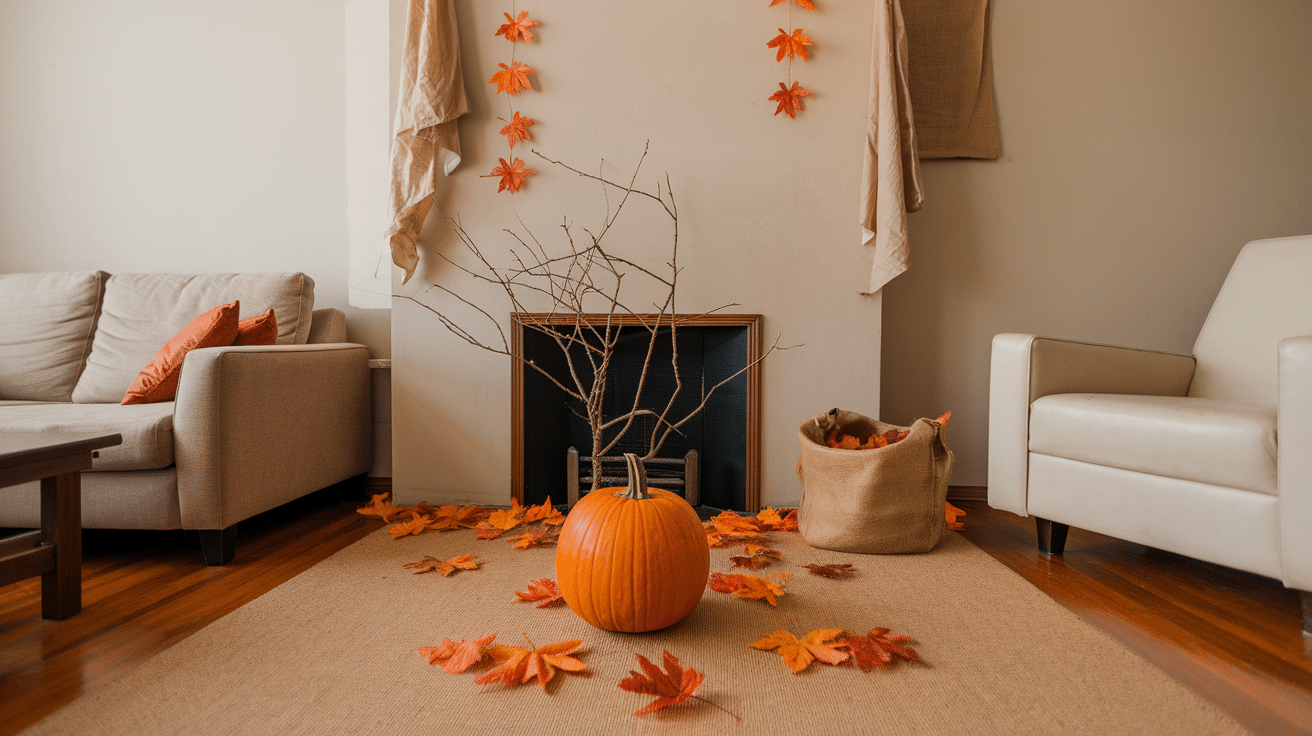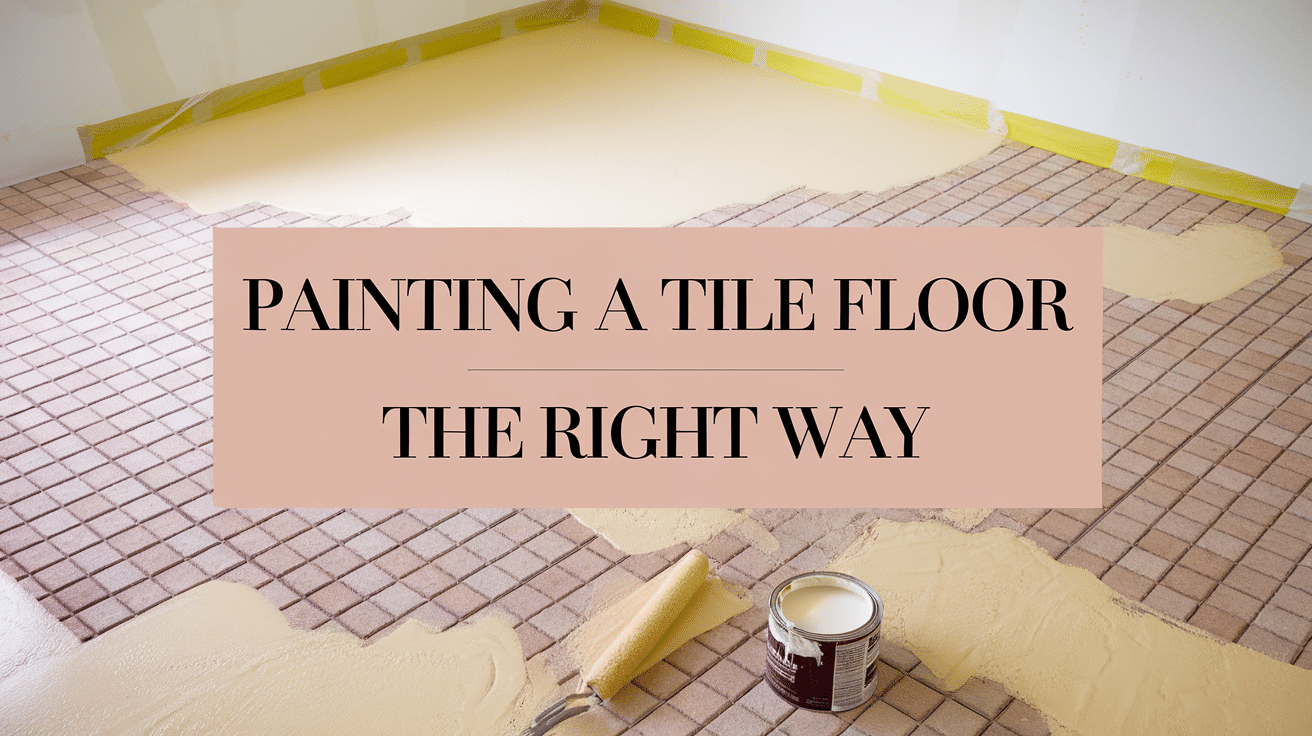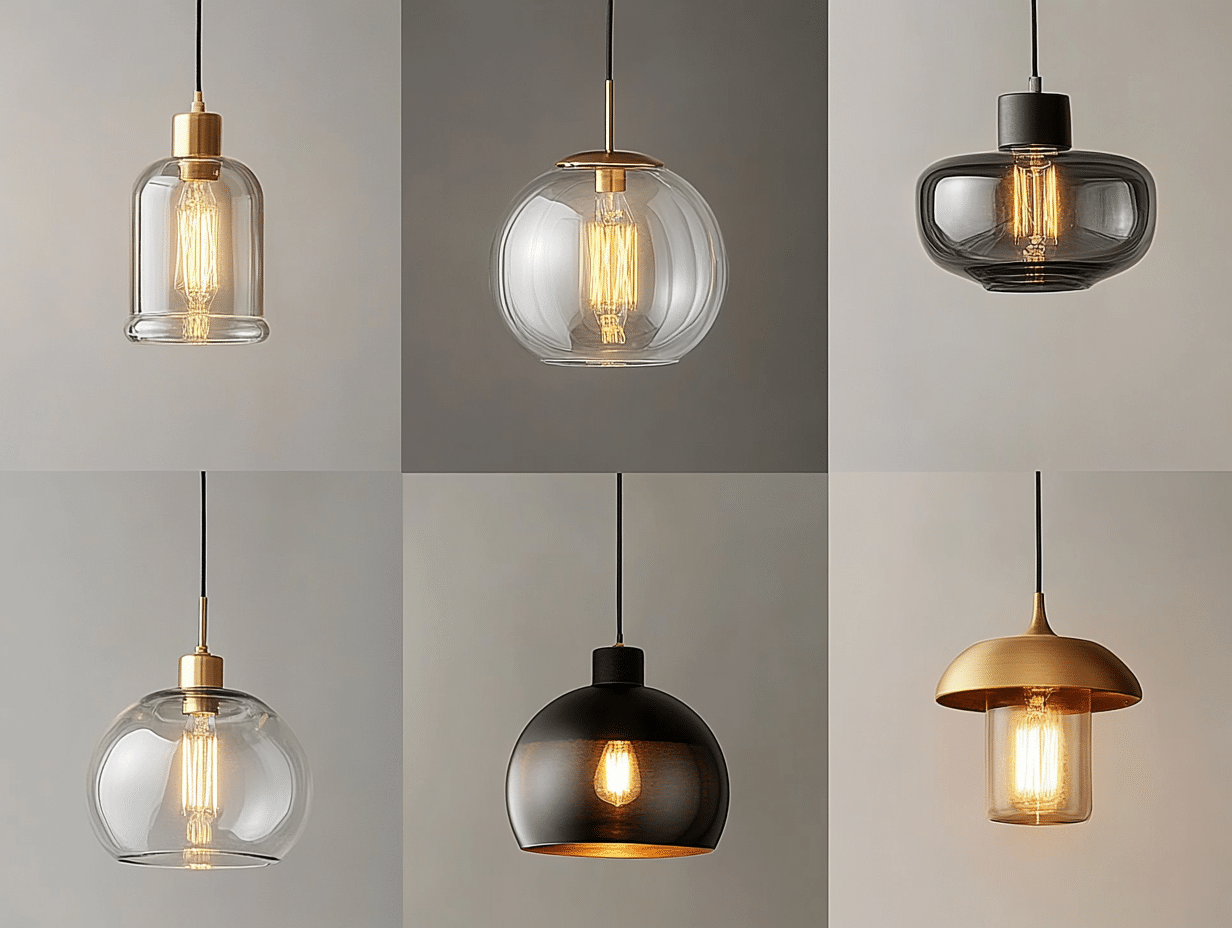35 Best Paint Colors for Small Bathrooms
Choosing the right paint color for a small bathroom can feel like a puzzle.
It’s not just about picking a pretty shade; it’s about creating the illusion of space, adding personality, and ensuring your bathroom feels like a place you actually want to spend time in.
Over the years, I’ve helped countless homeowners transform their tiny bathrooms into stylish, functional retreats simply by selecting the perfect paint color.
Whether you’re after a bright and airy vibe or something cozy and warm, the right paint can completely change the atmosphere.
Let’s dive into the best colors and how they can make a big impact on your small bathroom.
Paint Colors for Small Bathrooms
1. Soft White
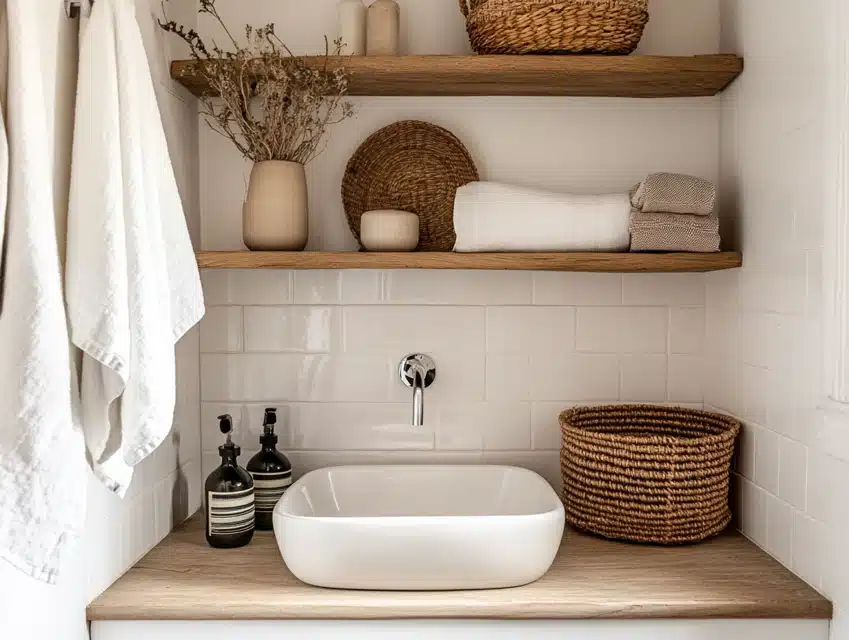
Soft white is a color I always recommend for small bathrooms. It’s timeless, easy to work with, and instantly makes any space feel bigger.
It reflects light beautifully, creating an open and airy vibe. Whether your bathroom gets natural light or relies on artificial lighting, soft white will brighten it up.
It’s a perfect option if you’re looking for something clean and classic.
Why I Love It
- It’s simple but effective, making small spaces feel fresh and inviting.
- It reflects both natural and artificial light, enhancing the brightness.
- It works well with almost any style, from modern to rustic.
How to Style It
- Pair it with chrome or matte black fixtures for a sleek and modern look.
- Add natural wood shelves or a woven basket to bring warmth and texture.
- Use soft white trim and baseboards for a cohesive finish.
My Personal Experience
- When I painted my guest bathroom soft white, it felt like a completely new space.
- It looked twice as big, and the clean, fresh vibe made it feel like a spa.
- Guests often comment on how bright and inviting it is, which always makes me smile.
- It’s a simple choice but one that delivers incredible results.
2. Light Gray
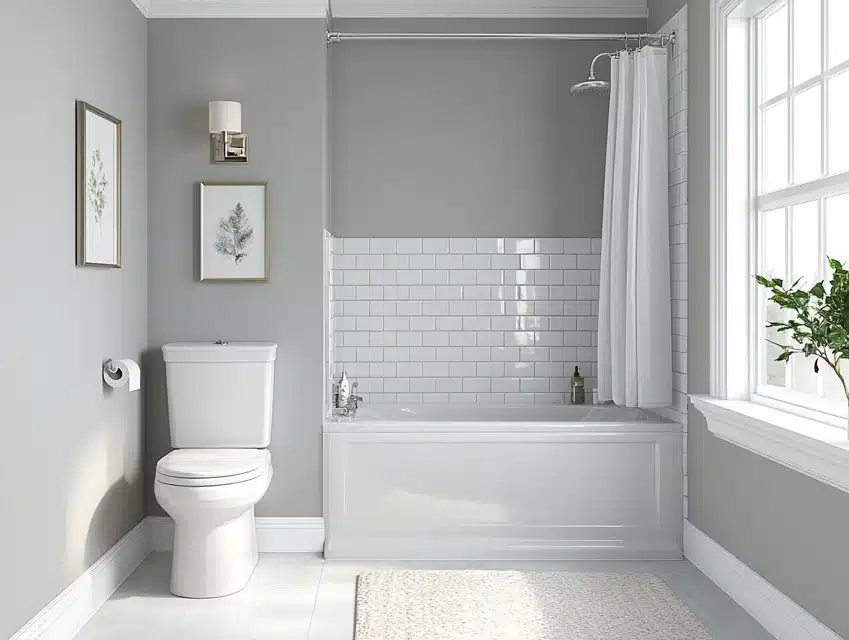
Light gray is a sophisticated neutral that works wonders in small bathrooms.
It adds depth to the space without overpowering it.
I often recommend it to clients who want a modern, clean look with just a touch of warmth.
It strikes the perfect balance between elegance and practicality, making it a popular choice for small spaces.
Why I Love It
- Light gray offers a versatile foundation that pairs well with various decor styles.
- It adds subtle depth to the space, making it feel larger and more dynamic.
- It works beautifully with both natural and artificial lighting.
How to Style It
- Pair it with white tiles or countertops to create a crisp contrast.
- Use silver or brushed nickel fixtures to complement the cool tones.
- Add soft accents like a pastel rug or decorative plants for a cozy touch.
My Personal Experience
- When I used light gray in my bathroom, it instantly elevated the space.
- It felt elegant without being too formal, and the color worked seamlessly with my white vanity and glass shower.
- The best part? It didn’t feel too cold or sterile—it had just enough warmth to make it inviting.
3. Pale Blue
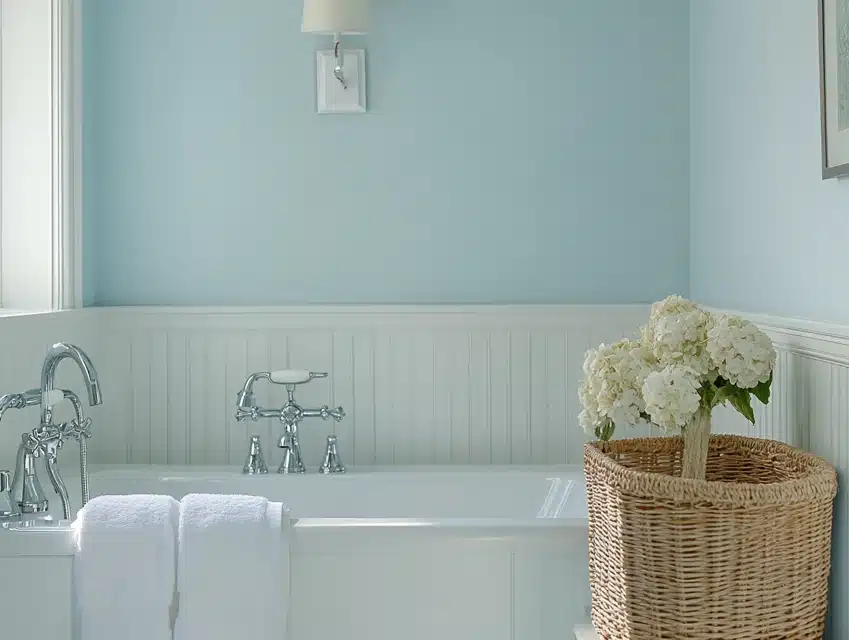
Pale blue is a serene and calming choice for small bathrooms. It evokes a spa-like atmosphere, giving your space a tranquil and airy feel.
The light, cool tone reflects natural light beautifully, which makes the room feel larger and more open.
Pale blue is especially ideal if you’re going for a coastal or refreshing vibe.
Why I Love It
- Pale blue creates a peaceful, calming environment that feels like an escape.
- It reflects light well, making even the smallest bathrooms appear more spacious.
- It pairs perfectly with white and natural materials for a clean, breezy aesthetic.
How to Style It
- Pair it with white wainscoting or beadboard for a classic coastal look.
- Add natural textures like woven baskets or a wooden stool to warm up the space.
- Use silver or chrome fixtures to enhance the cool tones and keep the look polished.
My Personal Experience
- I once used pale blue in a guest bathroom, and every time I walked in, I felt a sense of calm wash over me.
- Guests loved how it made the space feel like a mini spa retreat, especially when paired with fluffy white towels.
- It’s one of those colors that never goes out of style—it feels timeless and refreshing.
4. Sage Green
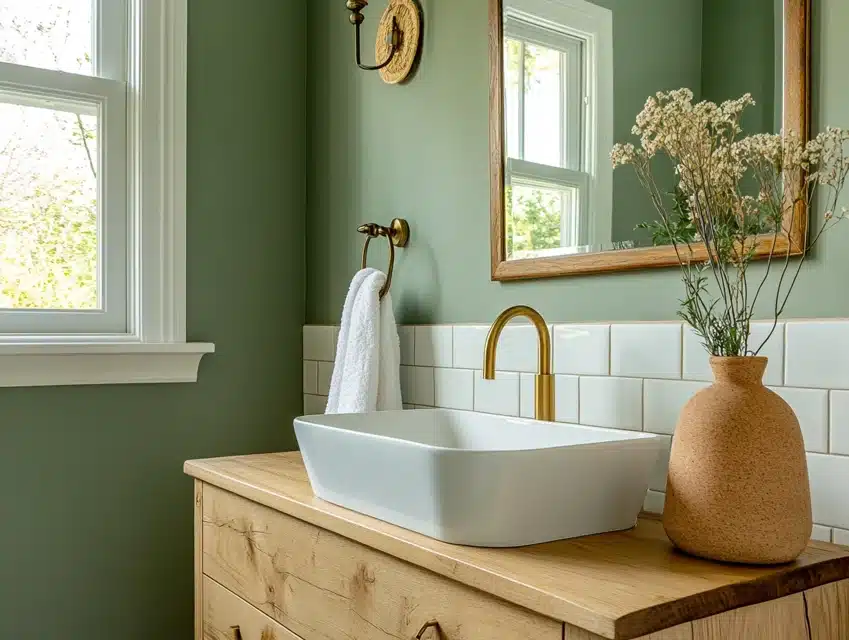
Sage green is a muted, earthy hue that adds a touch of nature to your bathroom.
It’s perfect for creating a serene, relaxing atmosphere, especially when paired with wooden or organic elements.
The soft green tone is easy on the eyes and works wonderfully in bathrooms with limited natural light, as it doesn’t overpower the space.
Why I Love It
- Sage green brings the outdoors in, creating a soothing and natural vibe.
- It’s a versatile shade that complements a wide range of bathroom styles, from rustic to contemporary.
- It pairs beautifully with neutral tones, adding a gentle pop of color without feeling too bold.
How to Style It
- Combine it with natural wood accents, like shelving or a vanity, for a grounded look.
- Use brushed brass or matte black fixtures to add a modern touch.
- Add soft white trim or tiles to keep the space bright and balanced.
My Personal Experience
- I painted my bathroom sage green last year, and it transformed the space into a calm oasis.
- The color paired beautifully with my bamboo vanity and linen shower curtain.
- Every time I step in, it feels like a little retreat from the chaos of daily life.
5. Cream
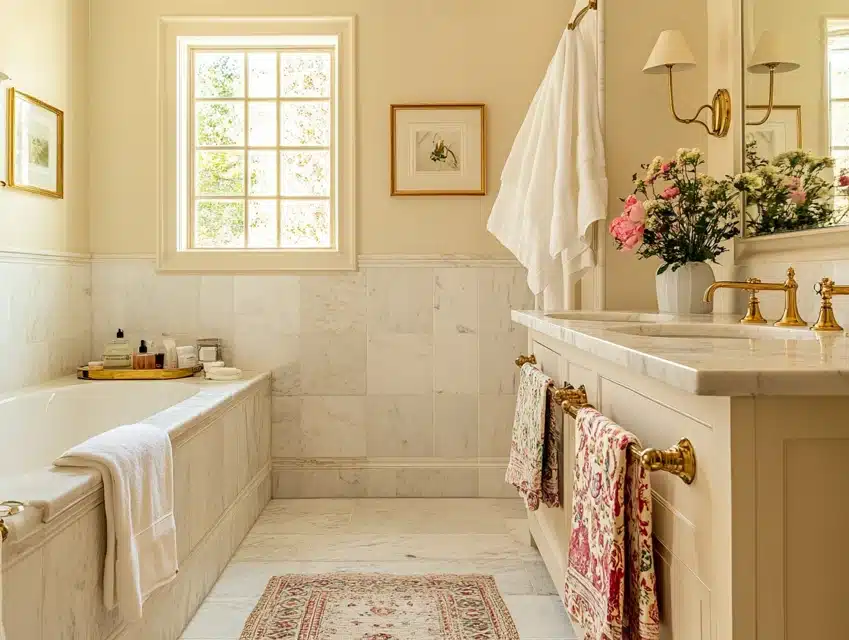
Cream is a warm, inviting off-white that adds a subtle elegance to small bathrooms.
It’s perfect for creating a light and airy feel without the starkness of pure white.
This versatile color blends seamlessly with almost any decor style, from traditional to contemporary, and works beautifully in spaces with both natural and artificial lighting.
Why I Love It
- Cream feels warm and cozy while still making the room feel spacious.
- It has a timeless appeal, working well with classic or modern aesthetics.
- It adds just enough warmth to prevent the space from feeling too sterile.
How to Style It
- Pair it with gold or brass fixtures to enhance the warm tones.
- Use cream tiles or walls as a base, then add colorful accents like patterned towels or a rug.
- Incorporate natural materials like marble or wood for added texture and sophistication.
My Personal Experience
- When I painted my small powder room cream, it instantly felt more elegant and welcoming.
- It worked beautifully with the vintage brass mirror and white sink I already had.
- Guests often compliment the space, saying it feels both cozy and chic—a combination I love.
6. Soft Peach
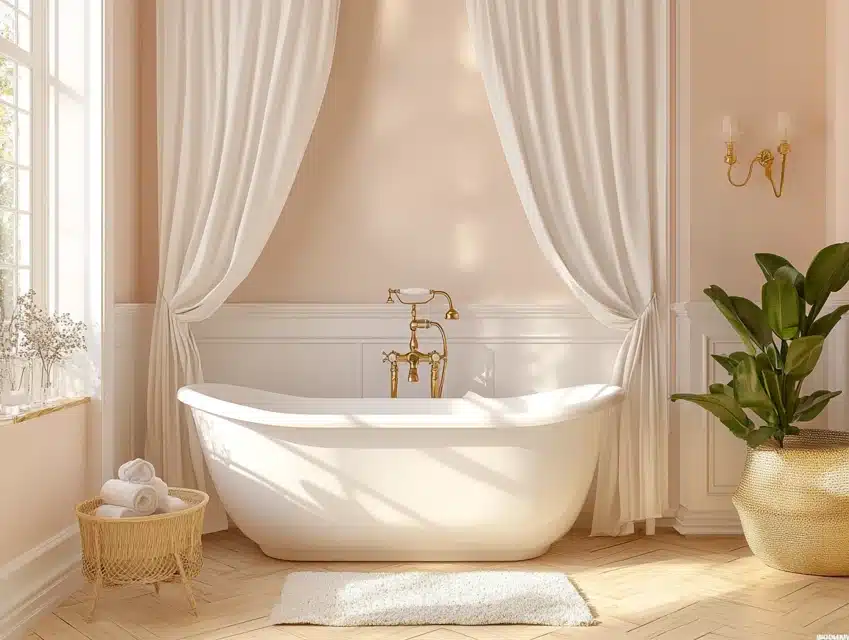
Soft peach is a delicate and inviting color that brings warmth to small bathrooms without overwhelming the space.
Its gentle tone adds a subtle hint of color, making the room feel cheerful and cozy.
Why I Love It
- Soft peach radiates warmth, making the bathroom feel more welcoming.
- It adds a touch of subtle elegance without being overpowering.
- It pairs effortlessly with neutrals and light wood accents for a balanced look.
How to Style It
- Pair soft peach walls with white fixtures to keep the space light and airy.
- Use gold or brass accents to enhance the warm undertones of the color.
- Add soft linen curtains or a patterned shower curtain for texture and style.
My Personal Experience
- I used soft peach in my childhood bathroom, and it always felt like a sunny, happy space.
- The warm hue complemented the vintage clawfoot tub and soft cream towels perfectly.
- It’s a color that brings a smile to my face every time I see it.
7. Blush Pink
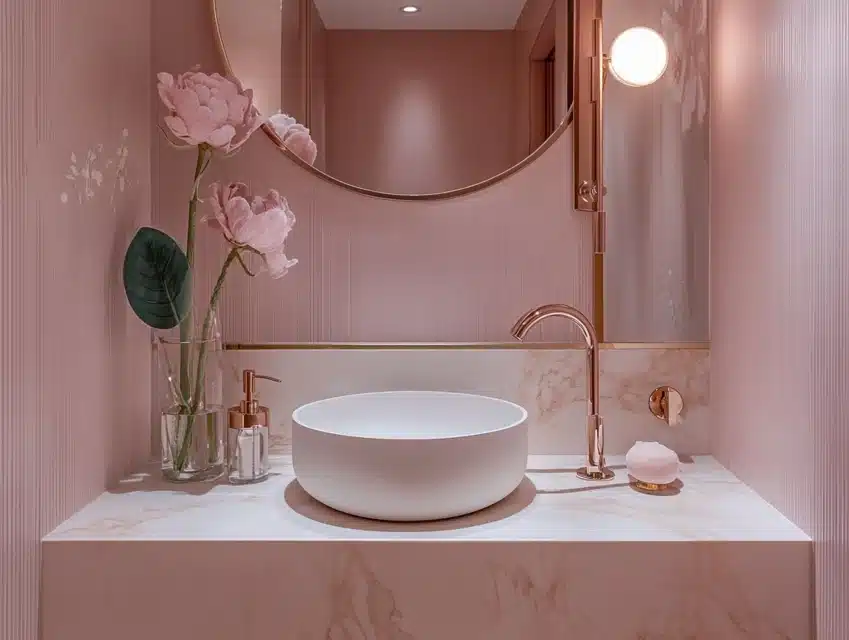
Blush pink is a trendy yet timeless shade that adds charm and sophistication to small bathrooms.
Its soft, rosy hue creates a light and airy feel while introducing a subtle splash of color.
Ideal for modern or feminine designs, blush pink brings a unique personality to the space.
Why I Love It
- Blush pink adds a playful yet refined vibe, perfect for chic bathroom designs.
- It reflects light beautifully, making small spaces feel more open and inviting.
- It works well with both bold accents and understated decor for added versatility.
How to Style It
- Pair blush pink walls with white or marble countertops for an elegant look.
- Add rose gold or brushed gold fixtures to enhance the rosy tones.
- Use muted floral patterns or soft gray accents to create a harmonious design.
My Personal Experience
- I painted a small powder room blush pink for a client, and it quickly became the most complimented space in their home.
- The color worked wonders in bringing warmth and elegance to the room without being too loud.
- Even the tiniest decor items, like a vase of white roses, stood out beautifully against the blush backdrop.
8. Sky Blue
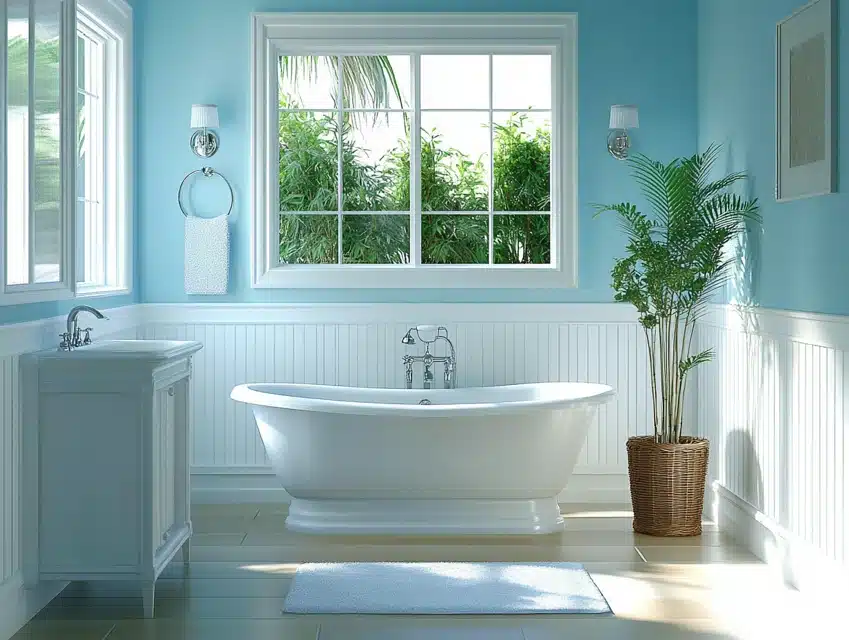
Sky blue is a light and airy shade that mimics the open sky, making it a fantastic choice for small bathrooms.
This refreshing color creates a calming and serene atmosphere, making your bathroom feel more expansive and spa-like.
It’s perfect for anyone looking to bring a touch of tranquility into their home.
Why I Love It
- Sky blue brings a sense of openness and serenity to small spaces.
- It pairs effortlessly with white and natural tones for a fresh, coastal look.
- It’s versatile, working well in both modern and traditional bathrooms.
How to Style It
- Combine sky blue walls with crisp white wainscoting for a timeless coastal aesthetic.
- Add silver or chrome fixtures to enhance the clean, modern feel.
- Use natural materials like bamboo or rattan for decor to balance the cool tones.
My Personal Experience
- I painted my guest bathroom sky blue last summer, and it instantly felt twice as big.
- The color made my white sink and fixtures pop, giving the room a clean and polished look.
- Every time I walk in, I feel like I’m stepping into a serene beach house—such a refreshing vibe!
9. Warm Beige
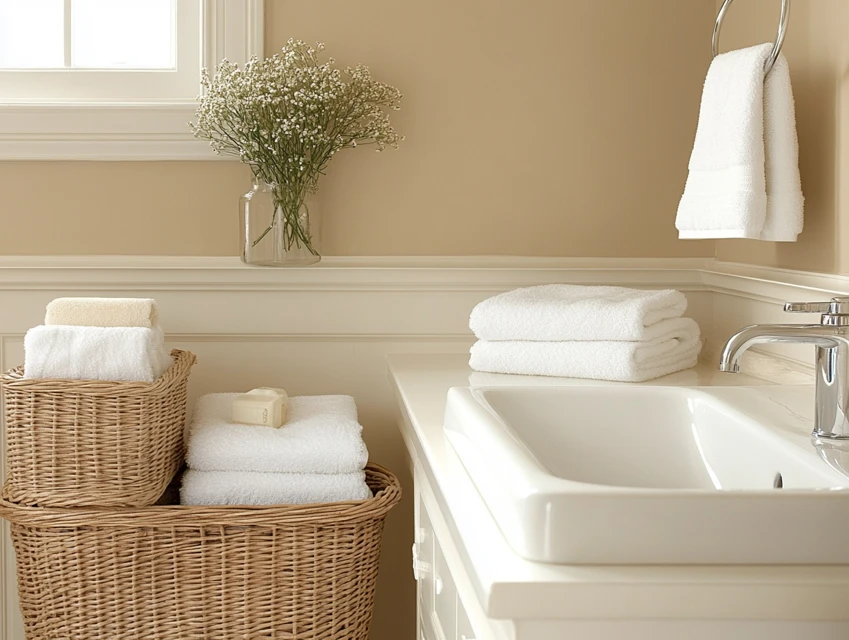
Warm beige is one of those colors that feels like a comforting hug. It’s soft, versatile, and effortlessly creates a cozy vibe.
This is a fantastic choice if you’re aiming for a small bathroom that feels timeless and inviting.
Beige doesn’t overpower the space, and its subtle warmth works wonders in reflecting light, making the room appear larger.
Why I Love It
- Warm beige adds a soft, grounded feel that works with almost any decor.
- It’s versatile and blends beautifully with both traditional and modern styles.
- The color makes small bathrooms feel comfortable and understatedly elegant.
How to Style It
- Pair warm beige walls with crisp white fixtures to keep the space feeling light.
- Add natural accents like wooden mirrors or wicker baskets for a cozy touch.
- Use soft, neutral linens and a textured rug to add depth without clutter.
My Personal Experience
- I once used warm beige in a bathroom makeover for a friend, and it completely transformed the space.
- The beige walls paired beautifully with her white subway tiles and brass fixtures.
- Every time I visit, she still tells me it’s her favorite room in the house—mission accomplished!
10. Light Taupe
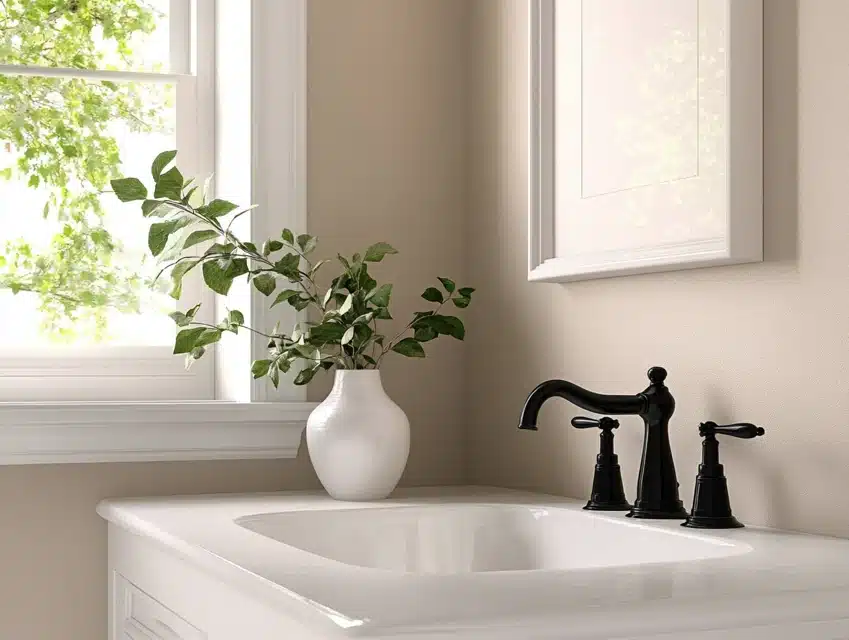
Light taupe is a lovely blend of gray and beige that brings balance and sophistication to small bathrooms.
It’s one of those colors that feels neutral but has just enough personality to stand out.
I love using it when I want a small space to feel grounded but not heavy.
Why I Love It
- Light taupe is a perfect balance of cool and warm tones, making it versatile.
- It works beautifully with both contemporary and rustic styles.
- It adds depth to small bathrooms without making them feel closed in.
How to Style It
- Pair light taupe walls with white or cream trims to highlight the color’s softness.
- Use black accents, like a matte black faucet, for a modern edge.
- Add greenery, like a small potted plant, to bring life to the neutral tone.
My Personal Experience
- I used light taupe in a rental property bathroom, and it was the perfect neutral that appealed to everyone.
- The walls looked stunning against the white fixtures and gray tiles, creating a cohesive look.
- It’s a go-to color for me when I’m working with clients who want something timeless but unique.
11. Icy Mint
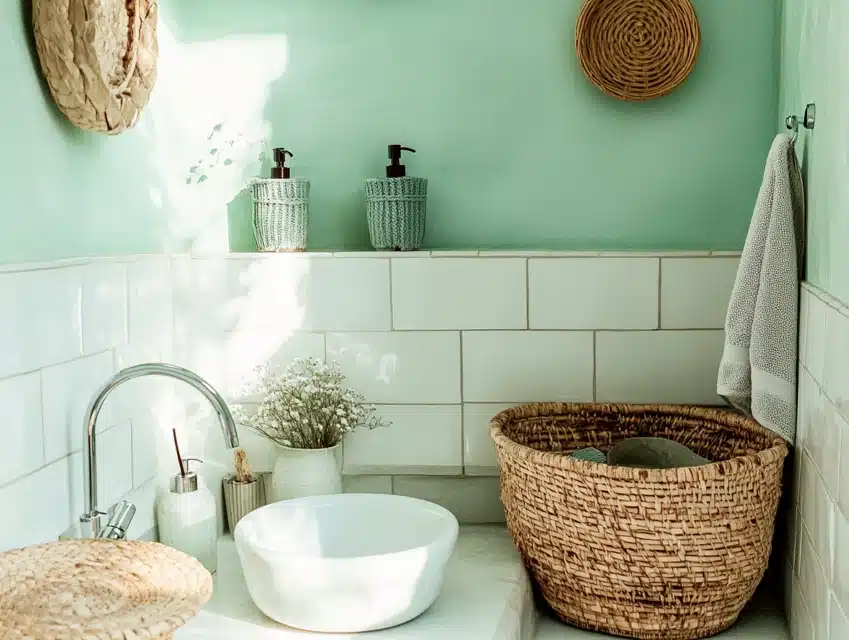
Icy mint is a refreshing pastel shade that brings energy and calm to a small bathroom.
It’s playful yet elegant, and the soft green undertone feels fresh and inviting.
This color has a way of making even the tiniest bathrooms feel vibrant and open.
Why I Love It
- Icy mint creates a fresh, lively atmosphere without being overwhelming.
- It works beautifully in bathrooms with natural light, giving off a cheerful vibe.
- It pairs wonderfully with modern or vintage decor for a versatile style.
How to Style It
- Combine icy mint walls with white tiles and silver fixtures for a crisp, clean look.
- Use textured elements like woven baskets or a soft rug to add warmth.
- Add a few mint-colored accessories, like soap dispensers or towels, to tie it all together.
My Personal Experience
- I painted my kids’ bathroom icy mint, and it instantly brought the space to life.
- The color made the room feel fresh and playful, and it’s a hit with everyone who sees it.
- Even on gray days, the bathroom feels bright and uplifting—honestly, one of my best paint decisions!
12. Pale Lavender
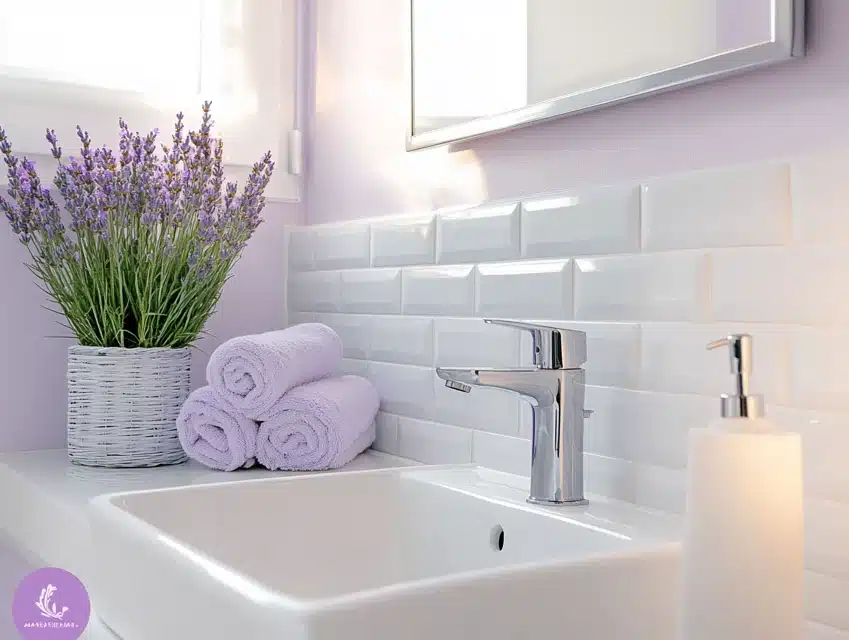
Pale lavender is one of those colors that feels both soothing and elegant.
It has a gentle, pastel hue that adds a unique charm to a small bathroom.
The soft purple undertone creates a calming atmosphere while still being visually interesting.
It’s perfect for anyone looking to add a subtle pop of color that’s not too bold.
Why I Love It
- Pale lavender brings a serene, spa-like feel to small spaces.
- It’s a sophisticated alternative to traditional neutrals.
- The color works wonderfully in both modern and vintage-inspired bathrooms.
How to Style It
- Pair pale lavender with crisp white tiles and fixtures for a clean, timeless look.
- Add silver or chrome accents, like faucets or towel racks, to enhance the elegance.
- Use lavender-themed decor, such as floral prints or subtle accessories, to tie everything together.
My Personal Experience
- I once painted a small guest bathroom pale lavender, and the transformation was magical.
- Guests often commented on how soothing and unique the color was—it felt like a boutique hotel bathroom.
- Adding a lavender-scented candle was the finishing touch, and now I always recommend this shade for anyone wanting a peaceful retreat.
13. Cool Aqua
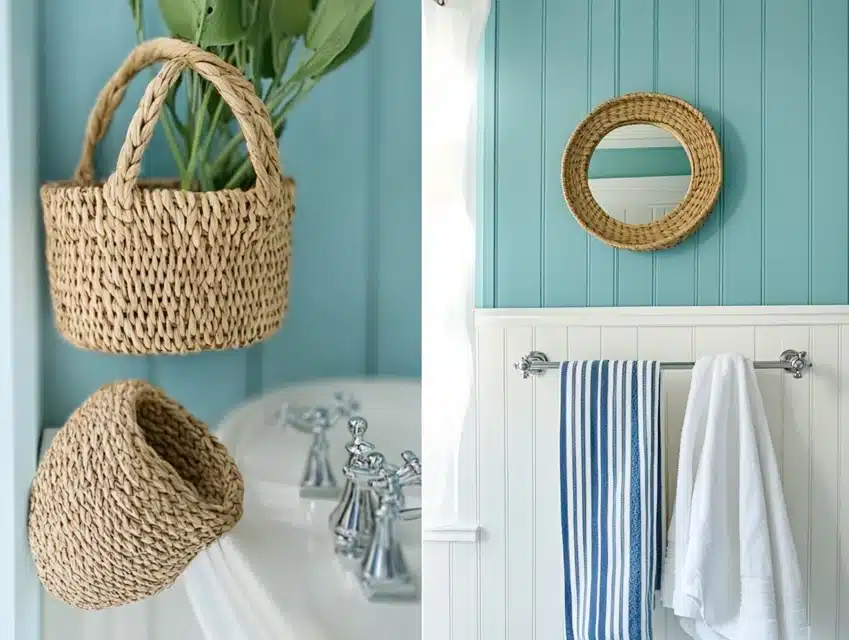
Cool aqua is a vibrant yet relaxing shade that brings the essence of the ocean right into your bathroom.
Its mix of blue and green tones creates a fresh, coastal vibe that’s perfect for smaller spaces.
It has just enough energy to make the room feel lively but remains soothing and serene.
Why I Love It
- Cool aqua instantly brightens up a small bathroom and makes it feel breezy.
- It works beautifully in bathrooms with natural light, amplifying the airy feel.
- The color pairs seamlessly with nautical or coastal-inspired decor.
How to Style It
- Pair cool aqua walls with white beadboard or shiplap for a charming coastal look.
- Use natural materials like seagrass baskets or wooden accents to complement the color.
- Add navy or white-striped towels for a touch of nautical flair.
My Personal Experience
- I once used cool aqua in a beach house bathroom, and it brought the ocean vibe indoors.
- The color was a hit with my clients, who loved how fresh and cheerful the space felt.
- Every time I visit, I feel like I’m on vacation—it’s amazing how a paint color can create that effect.
14. Soft Yellow
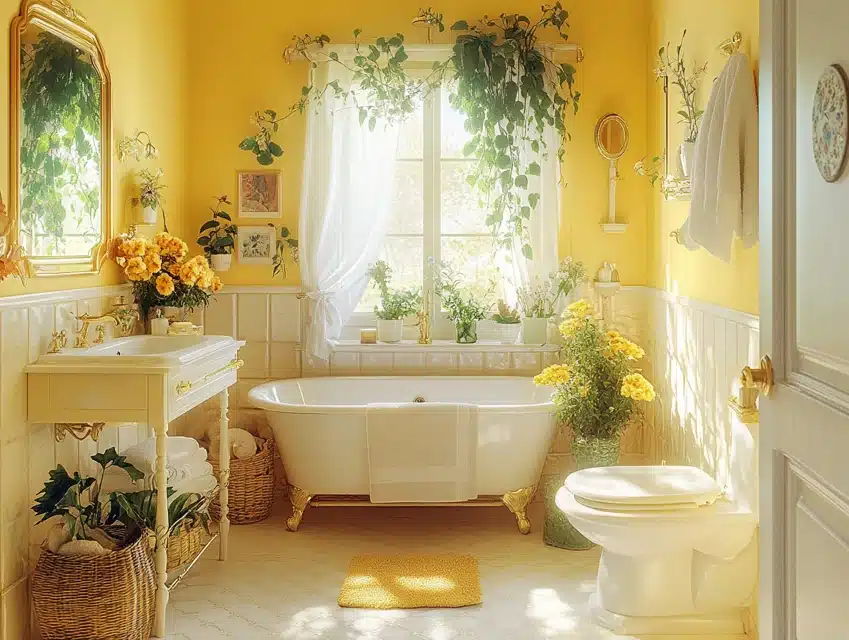
Soft yellow is like a ray of sunshine for your bathroom.
It’s cheerful and uplifting without being overpowering, making it a fantastic choice for small spaces.
This warm and inviting color makes any bathroom feel brighter and more welcoming, even if there’s limited natural light.
Why I Love It
- Soft yellow brings a cheerful, sunny vibe to small bathrooms.
- It’s warm and inviting, making the space feel cozy yet bright.
- The color works well with both modern and vintage-inspired decor.
How to Style It
- Pair soft yellow walls with white fixtures and trim for a clean and fresh look.
- Add brass or gold accents, like faucets or mirror frames, to enhance the warmth.
- Use floral or botanical-themed accessories to complement the sunny tone.
My Personal Experience
- I painted my powder room soft yellow, and it completely changed the mood of the space.
- It made the room feel brighter, even on overcast days, and guests often compliment its welcoming vibe.
- I love how the color pairs with my vintage-inspired fixtures—it’s the perfect balance of charm and brightness.
15. Light Teal
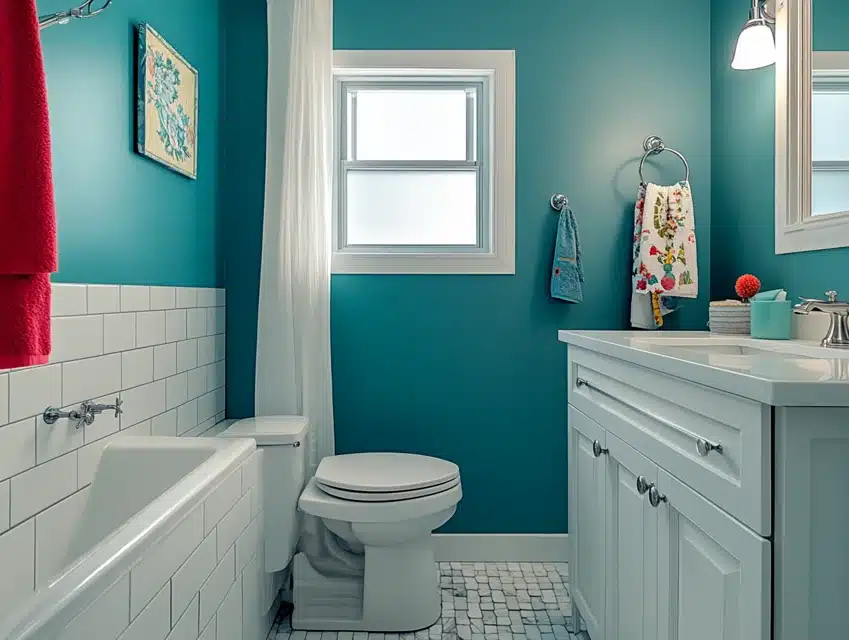
Light teal is an energetic yet soothing shade that adds personality to any small bathroom.
It’s the perfect blend of blue and green, striking a balance between playful and serene.
This color works wonders in making a bathroom feel fresh and inviting without overwhelming the space.
Light teal is ideal for those who want something vibrant but not too overpowering, especially in compact areas.
Why I Love It
- Light teal feels like a breath of fresh air in small spaces, bringing energy and calmness simultaneously.
- It reflects light beautifully, making your bathroom appear larger and more open.
- The color has a versatile vibe that works with coastal, modern, or even bohemian decor styles.
How to Style It
- Pair light teal walls with white trim and natural wood accents for a balanced and stylish look.
- Incorporate brushed nickel fixtures and simple geometric patterns for a modern touch.
- Add pops of navy, coral, or yellow in towels or decor to create contrast and interest.
My Personal Experience
- I painted a half-bath light teal in my old apartment, and it completely transformed the space.
- The color made the room feel lively but also gave it a calming effect—perfect for unwinding.
- My favorite part was how it paired with the white ceramic sink and wooden vanity, creating a look that was chic yet approachable.
16. Smoky Gray
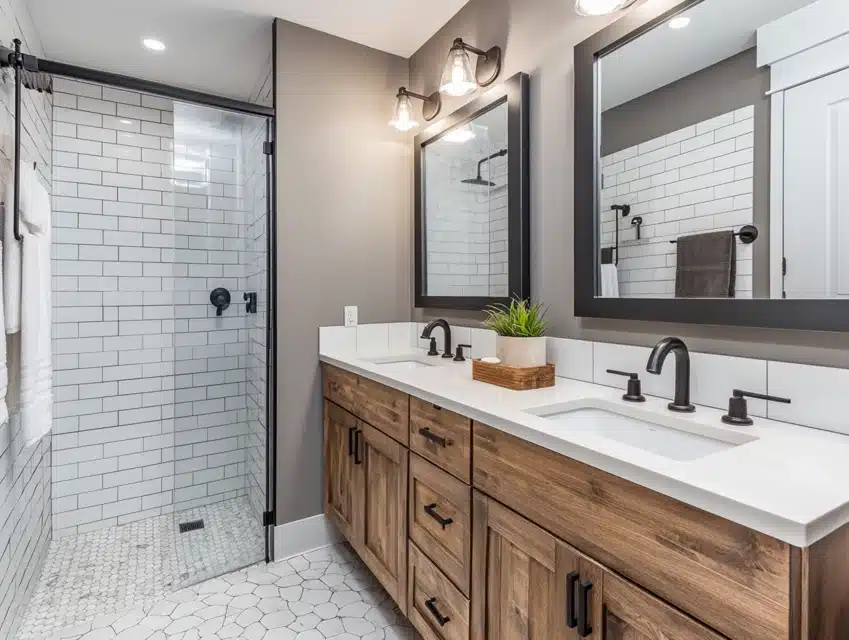
Smoky gray offers a sophisticated, contemporary feel that’s perfect for small bathrooms.
Unlike lighter grays, this slightly darker tone adds depth without making the room feel closed in.
Smoky gray works wonderfully as a neutral backdrop, allowing other design elements to stand out.
It’s bold without being overpowering, and its timeless quality makes it a favorite for modern and transitional bathrooms.
Why I Love It
- Smoky gray adds a modern, elegant touch to small bathrooms without overwhelming the space.
- It pairs beautifully with a variety of materials, from marble to wood.
- The shade offers depth and contrast while still feeling neutral and calming.
How to Style It
- Combine smoky gray walls with white or off-white tiles for a clean and polished look.
- Use matte black fixtures and accessories for a dramatic, high-end vibe.
- Add texture with plush towels, a woven rug, or a wooden vanity to balance the cool tones.
My Personal Experience
- When I used smoky gray in a client’s powder room, they were amazed at how luxurious it looked.
- We paired it with gold hardware, and the combination was simply stunning—it felt like a boutique hotel.
- Smoky gray also hides minor scuffs and wear, which makes it practical for high-traffic spaces.
17. Crisp White with Blue Undertones
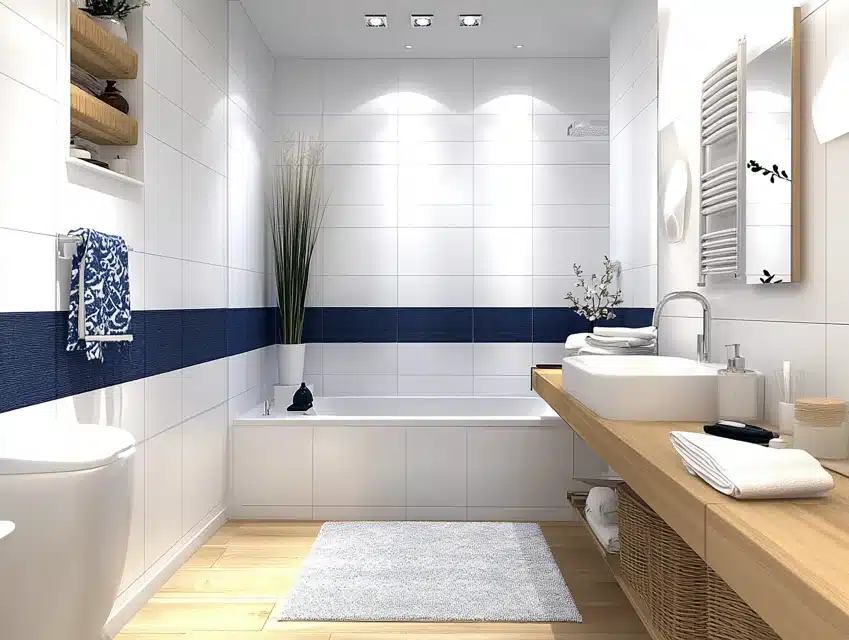
Crisp white with blue undertones is the perfect choice for creating a fresh, clean aesthetic in a small bathroom.
The slight hint of blue adds depth and a cool touch, making the white feel less stark and more inviting.
This color works wonderfully in both natural and artificial light, maintaining its bright and airy appearance throughout the day.
Why I Love It
- This shade brings a serene, spa-like vibe to small bathrooms, keeping the space fresh and open.
- It’s versatile and pairs well with both warm and cool-toned decor elements.
- The subtle blue undertone adds a layer of sophistication that pure white sometimes lacks.
How to Style It
- Pair it with navy or light blue accents, such as towels or decorative items, to enhance the undertone.
- Use silver or chrome fixtures for a sleek, cohesive look.
- Add touches of natural elements like greenery or bamboo to soften the cool tones.
My Personal Experience
- I painted my own master bathroom in this color, and I love how it makes the space feel tranquil and bright.
- It’s incredibly forgiving when it comes to lighting changes, staying crisp and fresh at all times.
- Friends and family always compliment the “spa vibes” whenever they see it—it’s one of my go-to recommendations.
18. Powder Blue
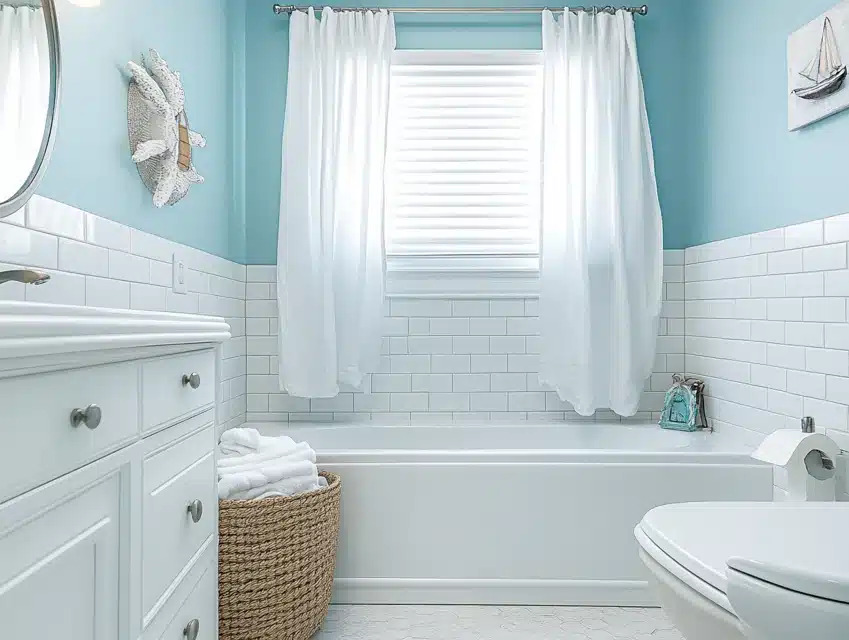
Powder blue has this magical ability to make any small bathroom feel like a serene retreat. It’s soft, calming, and gives the illusion of more space.
Every time I see powder blue on walls, it reminds me of a clear, peaceful sky on a perfect spring morning.
This color works particularly well in bathrooms because it brings a fresh and clean vibe, especially when paired with crisp white accents.
Why I Love It
- Powder blue creates a calming atmosphere, which is perfect for a bathroom where you want to unwind.
- It reflects light beautifully, making small spaces feel larger and more open.
- This shade adds just the right amount of color without overwhelming the room.
How to Style It
- Pair it with white subway tiles and a marble countertop for a timeless look.
- Add touches of silver or chrome in fixtures and accessories for a clean and modern feel.
- Include soft linens and perhaps a small piece of nautical decor for a subtle coastal vibe.
My Personal Experience
- When I painted my childhood home’s bathroom powder blue, it instantly became my favorite room in the house.
- I remember stepping into that bathroom and feeling like I was in a tiny spa—it was so peaceful.
- My mom still talks about how that small change made such a big difference. Guests loved it too!
19. Pale Coral
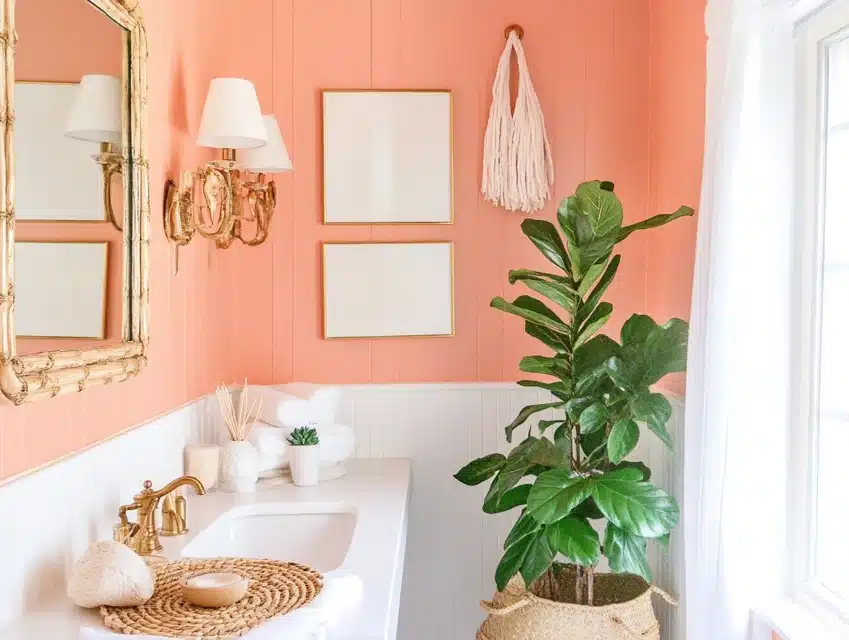
Pale coral is a beautiful choice if you want to inject some warmth and personality into a small bathroom.
It’s a soft, peachy-pink that feels cheerful yet sophisticated.
Every time I see pale coral in a space, it makes me think of warm sunsets or tropical vacations—it’s an instant mood booster.
Why I Love It
- Pale coral brings a touch of energy to a small bathroom without being overpowering.
- It’s warm and inviting, making it perfect for spaces that lack natural light.
- The color pairs surprisingly well with both modern and vintage styles.
How to Style It
- Use pale coral on walls and pair it with brass or gold fixtures for a chic, elegant look.
- Add white accents, like towels or tiles, to keep the space feeling bright and balanced.
- Consider incorporating rattan or wicker accessories for a bohemian touch.
My Personal Experience
- I once painted my niece’s bathroom pale coral, and it felt like a completely new space.
- She loved how warm and happy it felt every morning—she said it made her feel like she was waking up on a beach.
- Even now, every time I visit, that color brings a smile to my face—it’s just so uplifting.
20. Light Olive
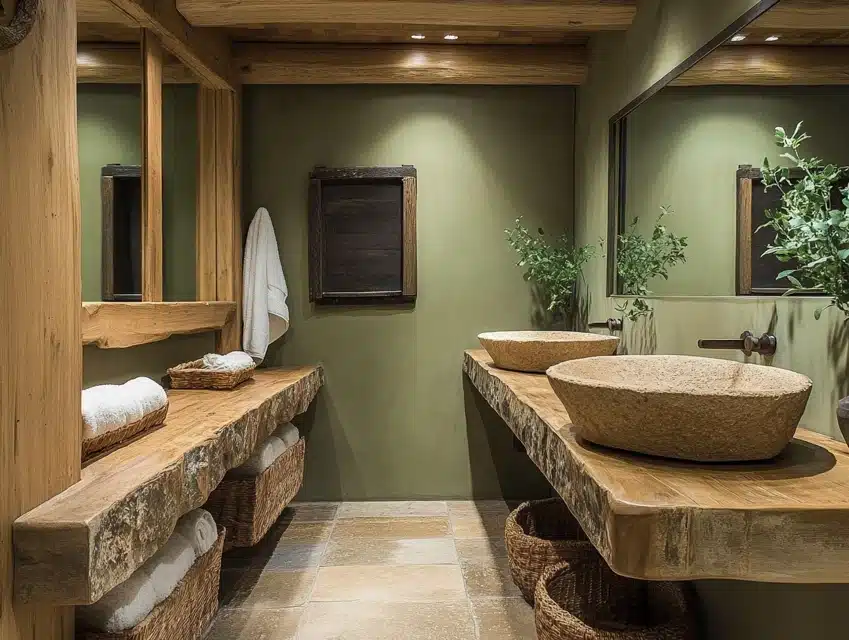
Light olive is such an underrated choice for small bathrooms, but it’s one of my favorites.
It’s a muted green with earthy undertones, and it adds a subtle touch of nature to any space.
I always recommend this color to clients who want something calming but a little unexpected.
Why I Love It
- Light olive has a natural, grounding quality that works beautifully in bathrooms.
- It’s warm enough to feel cozy yet muted enough to keep the space open and airy.
- This color pairs effortlessly with wood tones, stone finishes, and neutral palettes.
How to Style It
- Combine it with a wooden vanity and stone countertops for an earthy, spa-like feel.
- Use black or oil-rubbed bronze fixtures for a striking contrast.
- Add potted plants or botanical artwork to enhance the natural vibe.
My Personal Experience
- I used light olive in a client’s tiny guest bathroom, and it transformed the space into a tranquil haven.
- The client told me that their guests always comment on how relaxing it feels in there—it’s become a conversation starter.
- Personally, it reminds me of hiking through lush forests, and that connection to nature is so refreshing in a home.
21. Subtle Beige
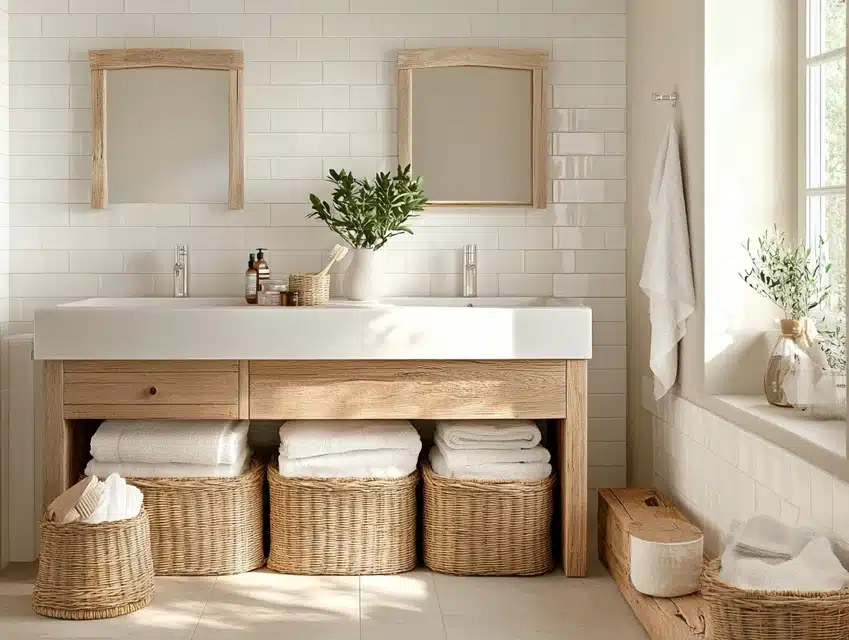
Subtle beige is the ultimate neutral color that works wonders in small bathrooms.
It’s warm, timeless, and so versatile that you can pair it with practically anything.
I always feel like beige gets an unfair reputation for being boring, but when used right, it can make a space feel elegant and inviting.
Picture a cozy little spa nook—it’s that kind of vibe.
Why I Love It
- Subtle beige creates a warm and welcoming environment without stealing attention.
- It blends beautifully with various styles, whether you’re going for rustic, contemporary, or classic.
- The color reflects just enough light to make a small bathroom feel open but still cozy.
How to Style It
- Pair it with white tiles and natural wood accents for a clean yet organic look.
- Use brushed nickel or gold fixtures to enhance the warmth and elegance of the space.
- Incorporate textured elements like woven baskets or linen towels to add depth.
My Personal Experience
- When I helped a friend redo her bathroom, she was skeptical about beige but wanted something timeless. We went with a subtle beige, and she couldn’t believe the transformation.
- The room felt more cohesive, warm, and polished. She later told me it became her favorite room in the house!
- Personally, I’ve always found beige to be a comforting color—it’s like a soft hug for your home.
22. Light Blush
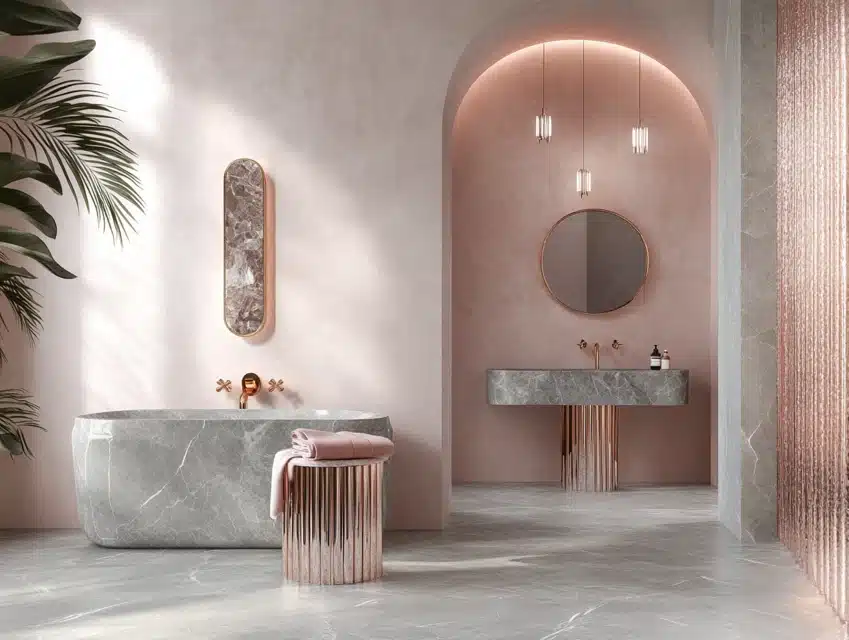
Light blush is like adding a soft, romantic glow to your bathroom.
It’s a barely-there pink that feels gentle, warm, and so stylish.
Whenever I see light blush, I think of luxury boutique hotels that manage to look feminine yet sophisticated at the same time.
Why I Love It
- It adds a subtle hint of color without overwhelming the space.
- Light blush works wonderfully with both natural and artificial light, creating a soft, flattering ambiance.
- The color feels unique yet understated, making it a great choice for those who want something a little different.
How to Style It
- Pair it with white or gray marble for a luxurious feel.
- Use rose gold or brass fixtures to enhance the pink undertones.
- Add delicate details like soft towels or a small vase of fresh flowers for a chic touch.
My Personal Experience
- I painted my powder room light blush a few years ago, and I remember how nervous I was—it felt like a bold choice for me at the time.
- The result? It’s now my favorite bathroom in the house. Every time I walk in, it feels so calming and elegant.
- Guests often compliment the color, and I love telling them how it transformed such a small space.
23. Muted Ice Blue
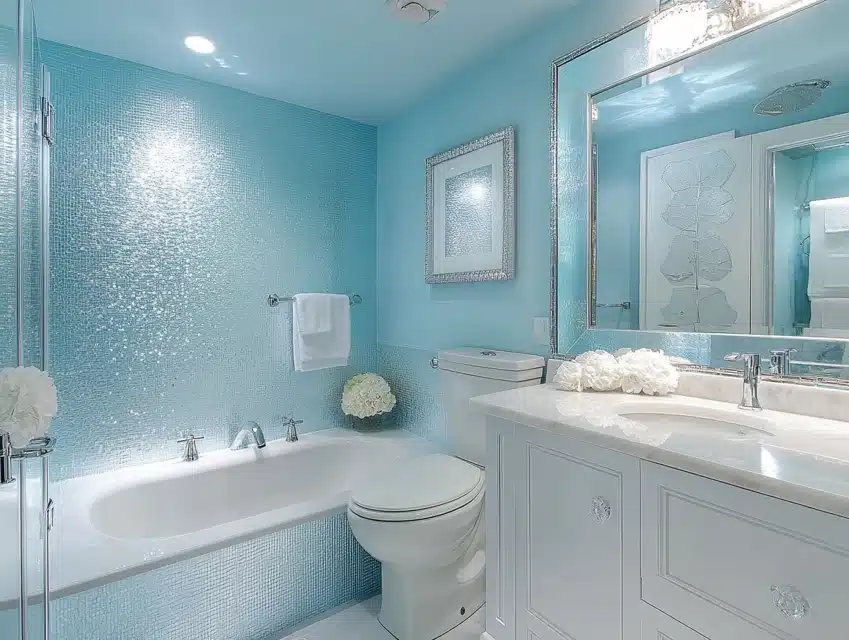
Muted ice blue is the perfect choice if you’re looking for something cool, crisp, and incredibly calming.
It’s soft enough not to overwhelm a small bathroom but still offers a touch of color to make the space feel unique.
Whenever I use muted ice blue in a project, it always reminds me of a peaceful winter morning—so serene and refreshing.
Why I Love It
- The soft blue tones create a tranquil environment that’s ideal for bathrooms.
- It reflects light beautifully, giving the illusion of more space.
- Muted ice blue pairs well with various design styles, from coastal to modern.
How to Style It
- Pair it with white or light gray accents for a clean and refreshing look.
- Use silver or chrome fixtures to enhance the cool tones in the color.
- Incorporate frosted glass elements or sheer curtains for an added sense of lightness.
My Personal Experience
- I used muted ice blue in a client’s bathroom makeover, and they couldn’t stop raving about how much brighter and bigger the space felt.
- Every time I see this color, it takes me back to a seaside cabin I stayed in once—its bathroom walls were the exact same shade, and it was the most calming space.
- It’s one of those colors that instantly puts you at ease, which is exactly what you want in a bathroom.
24. Light Khaki
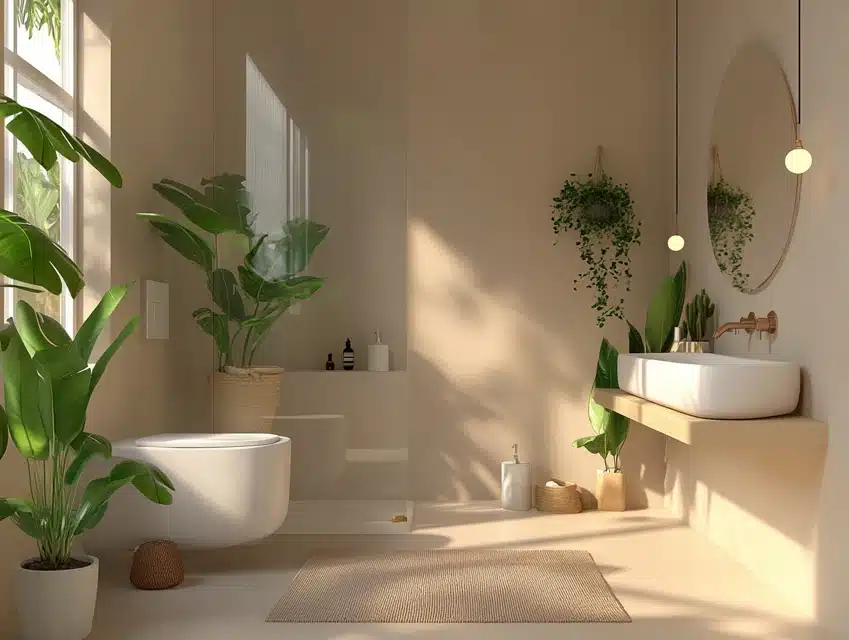
Light khaki is a warm, earthy shade that brings a grounded yet cozy feel to a small bathroom.
It’s a wonderful alternative to stark whites or grays, offering a touch of nature without being overpowering.
I like to think of light khaki as the color equivalent of a comfy, worn-in sweater—it’s understated, neutral, and works with almost everything.
Why I Love It
- It has a natural warmth that creates a welcoming and relaxing atmosphere.
- Light khaki complements wood tones and organic textures beautifully.
- The color is subtle yet distinctive, making it perfect for small spaces where you want a little personality.
How to Style It
- Pair it with white accents and brushed bronze fixtures for a warm, rustic feel.
- Use jute or sisal rugs and wooden accessories to enhance the earthy tones.
- Incorporate live greenery to add a fresh, organic vibe.
My Personal Experience
- I once used light khaki in a small bathroom renovation for a nature-loving client. The result was stunning—it felt like stepping into a serene forest retreat.
- I even considered repainting my own bathroom in light khaki after seeing how calming it looked.
- The best part? It paired effortlessly with everything from bamboo shelves to white ceramic tiles.
25. Frosted Lilac
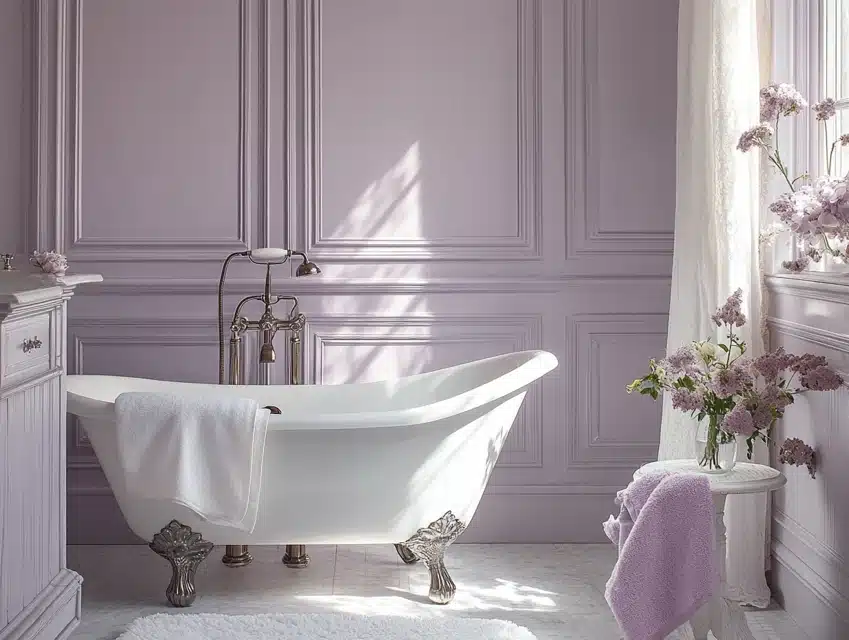
Frosted lilac is a soft, dreamy purple with subtle gray undertones, giving it a sophisticated yet calming presence.
It’s a great choice for anyone looking to add a little personality to their bathroom without going overboard.
To me, it feels like a delicate lavender field on a misty morning—peaceful, refined, and just a little whimsical.
Why I Love It
- Frosted lilac is gentle enough for small bathrooms while adding a unique touch of color.
- Its gray undertones make it versatile and easy to pair with neutral fixtures.
- The color creates a sense of calm and elegance, perfect for unwinding after a long day.
How to Style It
- Pair it with silver or pewter fixtures for a modern, polished look.
- Add textured white towels and light gray rugs for a layered effect.
- Incorporate subtle floral elements, like a lavender-scented candle or a vase of dried blooms, for a cohesive theme.
My Personal Experience
- I recommended frosted lilac to a friend who wanted something “a little different” but still classy for her guest bathroom. It ended up being the perfect choice—guests always comment on how calming and elegant the space feels.
- I love how frosted lilac looks with natural light streaming in; it gives the room a soft glow that’s absolutely enchanting.
- If you’re hesitant to try a purple shade, this is a safe and stunning option.
26. Off-White
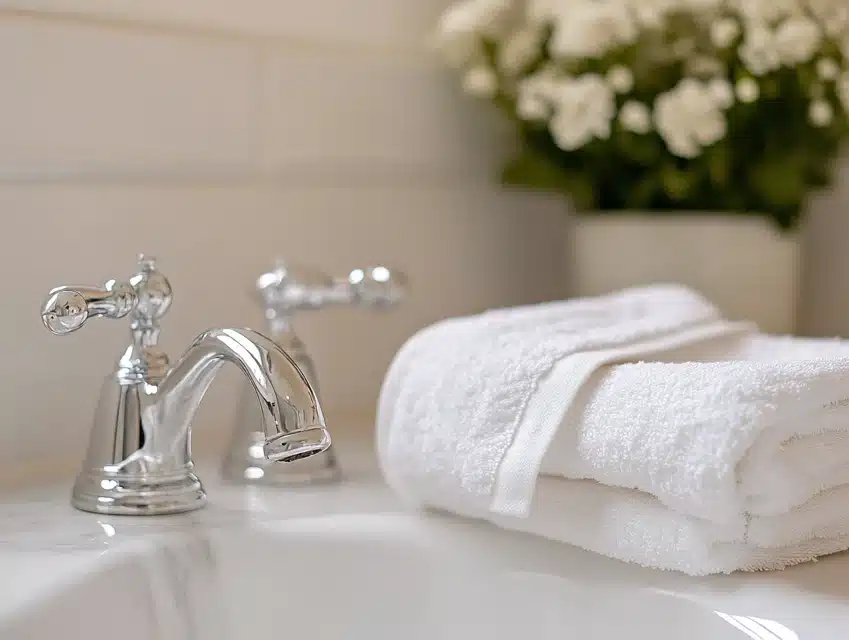
Off-white is a classic and timeless choice that never goes out of style.
It offers just enough warmth to feel cozy while staying light and airy.
Whenever I use off-white in a bathroom, I’m reminded of old-world European charm—simple, elegant, and effortlessly beautiful.
Why I Love It
- It’s a perfect alternative to stark white, adding warmth without losing brightness.
- Off-white works well with any style, from traditional to modern.
- The color reflects light beautifully, making even the smallest bathrooms feel open and inviting.
How to Style It
- Pair it with polished chrome or gold fixtures for a timeless look.
- Add marble or stone elements to elevate the design.
- Use soft linen or cotton towels in neutral tones for a cozy, layered effect.
My Personal Experience
- When I painted my bathroom off-white, I was amazed at how much bigger and brighter it felt. It’s incredible how such a subtle color can make such a big impact.
- A neighbor once described my bathroom as “the kind of space you want to linger in,” and I couldn’t agree more.
- Off-white is my go-to recommendation for anyone looking to refresh their bathroom without taking risks—it’s foolproof!
27. Dove Gray
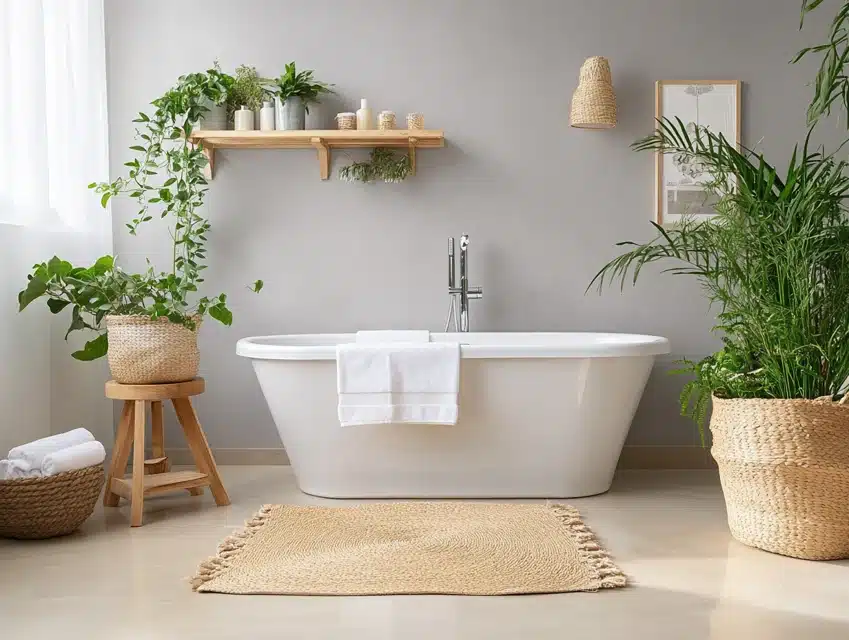
Dove gray is a soft, muted gray with just a hint of warmth, making it a versatile and elegant choice for small bathrooms.
It has a timeless charm that’s neither too cold nor overly bold, striking the perfect balance for creating a serene and stylish space.
When I think of dove gray, I picture a cozy, misty morning—a shade that wraps you in comfort.
Why I Love It
- Dove gray adds subtle sophistication without feeling heavy or overwhelming.
- It pairs beautifully with natural materials like marble, wood, and stone.
- The neutral undertone makes it adaptable to various styles, from modern to traditional.
How to Style It
- Combine it with white fixtures and brushed nickel hardware for a classic, clean look.
- Add a patterned rug or shower curtain in soft tones to introduce texture.
- Incorporate greenery or dried eucalyptus for a pop of organic color.
My Personal Experience
- I used dove gray in a bathroom project with marble accents, and the result was stunning. The color felt understated yet luxurious, and the client loved it.
- It’s a shade that works well in both natural and artificial light, making it versatile for any home.
- I love how it pairs with soft white towels and candles—it’s like creating a personal spa.
28. Seafoam Green
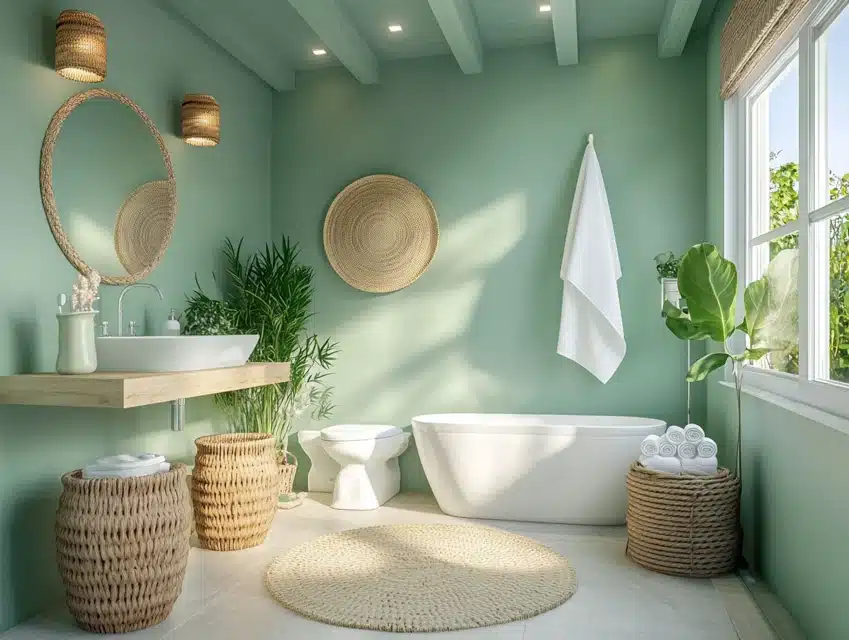
Seafoam green is a light, aquatic-inspired color that brings a breezy, coastal vibe to small bathrooms.
It’s perfect for those who love a touch of beachy tranquility without being too thematic.
Whenever I see seafoam green, I’m reminded of gentle ocean waves and sandy shores—it’s peaceful and invigorating all at once.
Why I Love It
- Seafoam green brightens up small spaces while adding a subtle pop of color.
- It creates a fresh, calming atmosphere, perfect for a bathroom retreat.
- The shade works wonderfully with both modern and coastal-inspired designs.
How to Style It
- Pair it with white fixtures and light wood accents for a natural, beachy look.
- Add woven baskets or rope-inspired accessories for coastal charm.
- Introduce coral or seashell decor for a playful nod to the seaside.
My Personal Experience
- I painted a friend’s powder room in seafoam green, and it transformed the space. The color was light and airy but had enough character to make a statement.
- It’s one of those shades that makes you feel instantly relaxed the moment you step in.
- I’ve even considered using seafoam green in my own home—it’s just so uplifting.
29. Sandstone
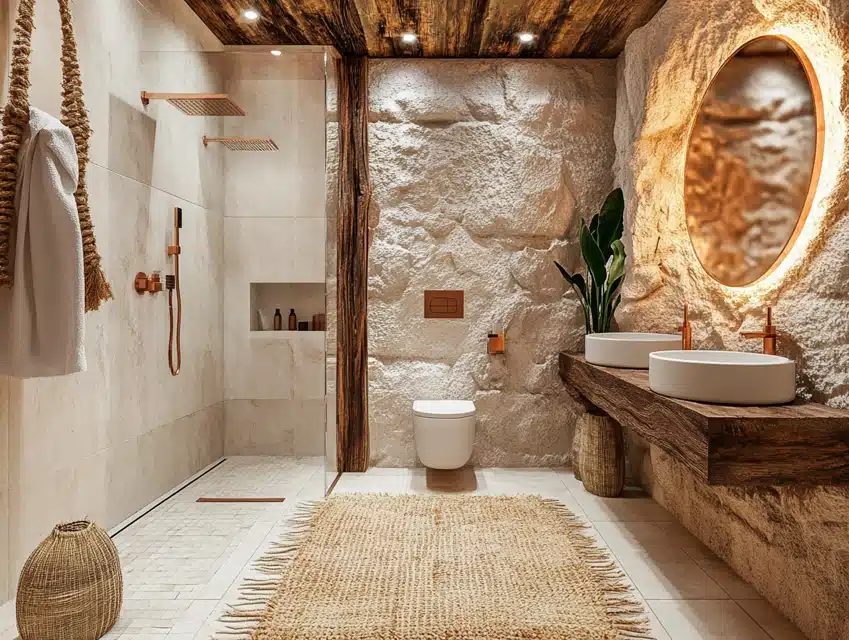
Sandstone is a warm, earthy tone that mimics the natural look of sand, creating a cozy and grounding effect in small bathrooms.
It’s a fantastic choice for those who want a bit of warmth and depth without veering into overly bold territory.
For me, sandstone feels like a warm embrace—it’s understated but packed with character.
Why I Love It
- Sandstone has a rich, natural vibe that complements earthy and rustic styles.
- It adds warmth to small spaces without making them feel cramped.
- The color pairs effortlessly with a variety of materials, including stone and ceramic.
How to Style It
- Combine sandstone walls with white or cream fixtures for a balanced look.
- Add earthy textures like linen curtains or jute rugs for a cohesive design.
- Incorporate metallic accents, like bronze or copper, to enhance the warm tones.
My Personal Experience
- I once used sandstone in a farmhouse-style bathroom renovation, and it was a game-changer. The space felt grounded and inviting, with a touch of rustic elegance.
- The client loved how versatile it was—easy to style and impossible to tire of.
- It’s a shade that feels timeless and perfect for creating a calming sanctuary.
30. Buttercream
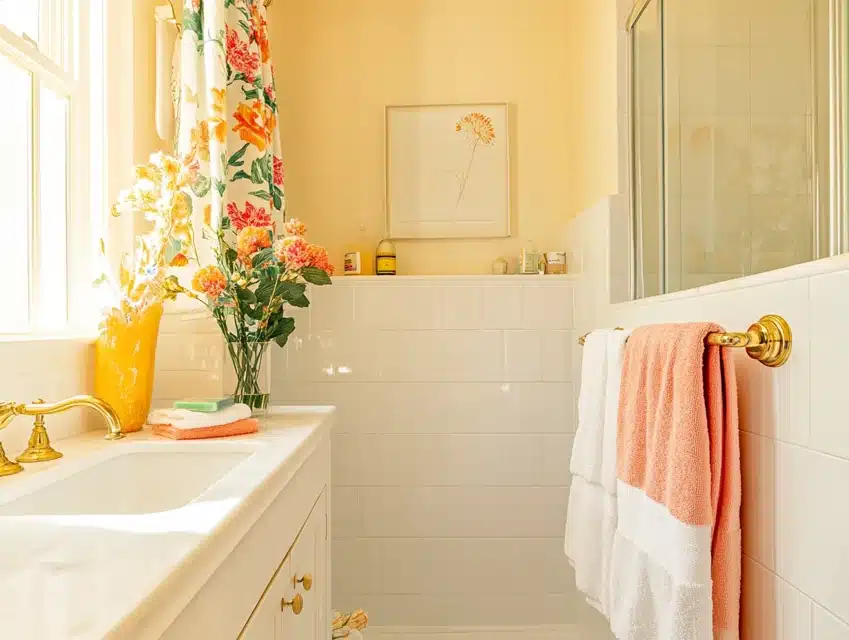
Buttercream is a soft, yellowish-white shade that brings a warm and sunny vibe to small bathrooms.
It’s cheerful and inviting, making it a fantastic choice if you want a space that feels cozy yet fresh.
To me, buttercream reminds me of sunlit mornings—a color that makes you smile.
Why I Love It
- Buttercream adds warmth without overpowering the room.
- It works beautifully with both modern and vintage bathroom designs.
- The subtle yellow undertone brightens up even the smallest spaces.
How to Style It
- Pair it with white or light wood accents for a clean, cohesive look.
- Add colorful towels or accessories in soft blues or greens for a playful contrast.
- Use brushed brass or gold hardware to complement its warm tones.
My Personal Experience
- I recently recommended buttercream for a client’s guest bathroom, and it was a hit. The warmth of the color made the space feel welcoming and chic.
- It’s one of those shades that looks great in both natural and artificial light.
- Personally, I love how it pairs with vintage mirrors and soft, floral accents—it’s like stepping into a classic European retreat.
31. Pale Silver
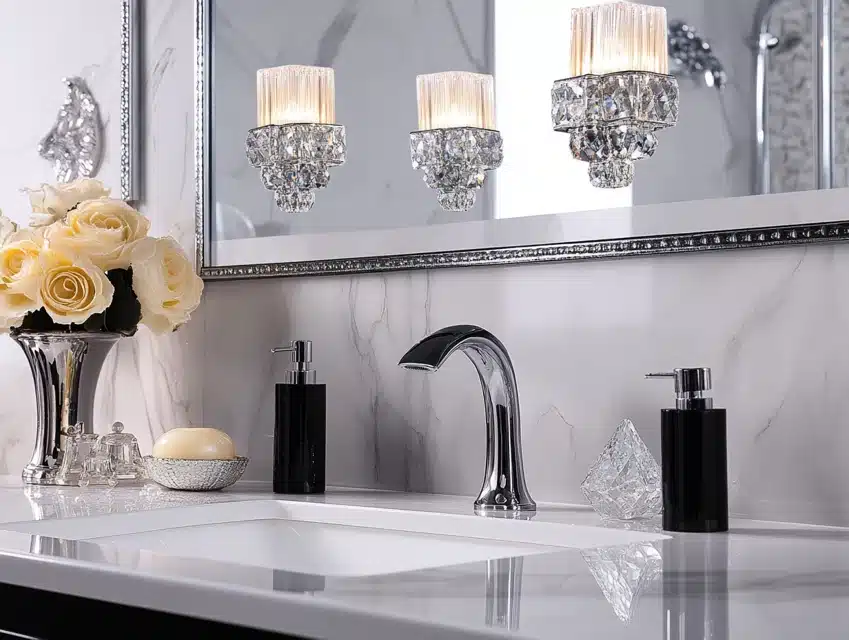
Pale silver is a shimmering gray that reflects light beautifully, making small bathrooms feel bigger and more elegant.
It’s modern yet timeless, with a soft metallic quality that elevates any space.
Whenever I use pale silver, I think of moonlight—subtle, radiant, and enchanting.
Why I Love It
- Pale silver enhances light reflection, creating a more open feel.
- It pairs seamlessly with both cool and warm tones, making it incredibly versatile.
- The slight sheen adds a touch of luxury without being too flashy.
How to Style It
- Pair it with marble countertops or tiles for a sophisticated look.
- Add black fixtures or accents for a bold, modern contrast.
- Use crystal light fixtures or mirrored decor to amplify the reflective quality.
My Personal Experience
- I once used pale silver in a client’s master bathroom, and it was stunning. The reflective quality made the room feel twice its size.
- It’s a go-to choice when you want a neutral shade with a bit of personality.
- Personally, I love how pale silver looks with glass shower doors and chrome finishes—it’s effortlessly stylish.
32. Misty Blue
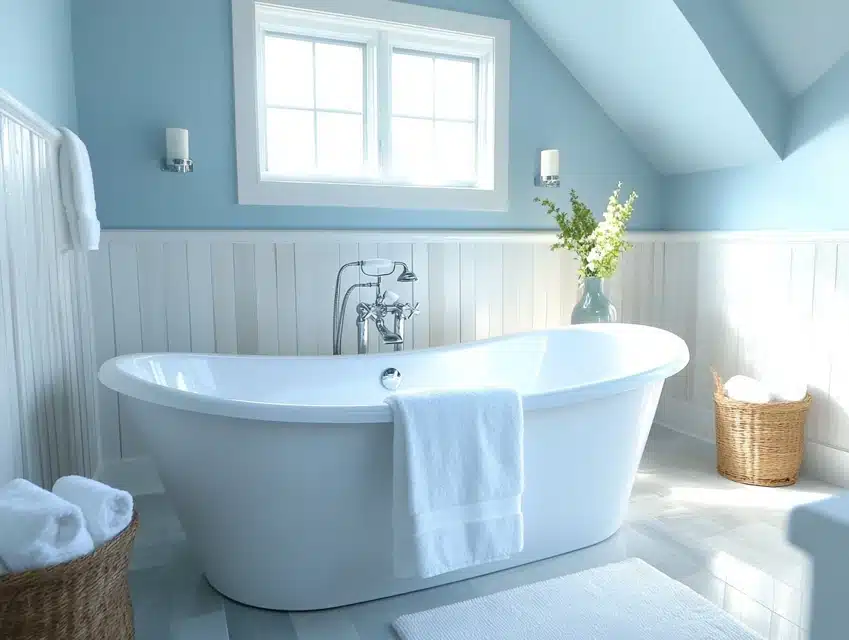
Misty blue is a calming gray-blue shade that exudes serenity and modern charm.
It’s perfect for small bathrooms where you want a touch of color without overwhelming the space.
To me, misty blue feels like a breath of fresh air—peaceful and rejuvenating.
Why I Love It
- Misty blue creates a spa-like atmosphere with its soothing tones.
- It pairs well with natural textures like wood and stone.
- The balance between gray and blue makes it versatile for various design styles.
How to Style It
- Pair it with crisp white fixtures and silver hardware for a clean, contemporary look.
- Add soft beige or tan towels to bring in warmth and contrast.
- Use textured tiles or shiplap walls to enhance its coastal charm.
My Personal Experience
- I recently painted a powder room in misty blue, and it became my favorite project of the year. The color had a calming effect that everyone who visited commented on.
- It’s one of those shades that looks expensive without being high-maintenance.
- I love how it pairs with natural light—it feels like bringing a bit of the outdoors in.
33. Light Terracotta
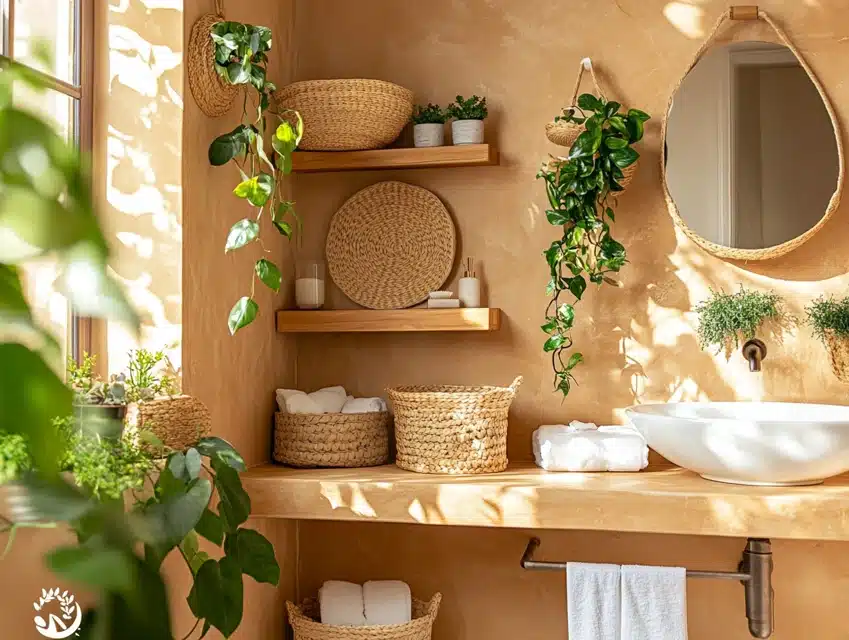
Light terracotta is a muted, earthy orange that brings a cozy and grounded feel to small bathrooms.
It’s warm and inviting without feeling overpowering.
To me, it feels like a nod to nature, reminiscent of terracotta tiles in charming Mediterranean homes.
Why I Love It
- Light terracotta adds warmth and depth to small spaces.
- It pairs well with natural materials like wood and stone.
- The earthy tone makes the room feel welcoming and relaxed.
How to Style It
- Combine it with white or cream tiles for a clean, balanced look.
- Use wicker baskets and wooden shelving for a rustic touch.
- Add greenery, like small potted plants, to enhance the natural vibe.
My Personal Experience
- A client with a vintage-style bathroom used light terracotta on the walls, and the result was stunning. The color tied in perfectly with their copper fixtures.
- It’s one of those shades that feels unique but still timeless.
- Personally, I love how it looks with textured textiles, like woven rugs or towels.
34. Soft Plum
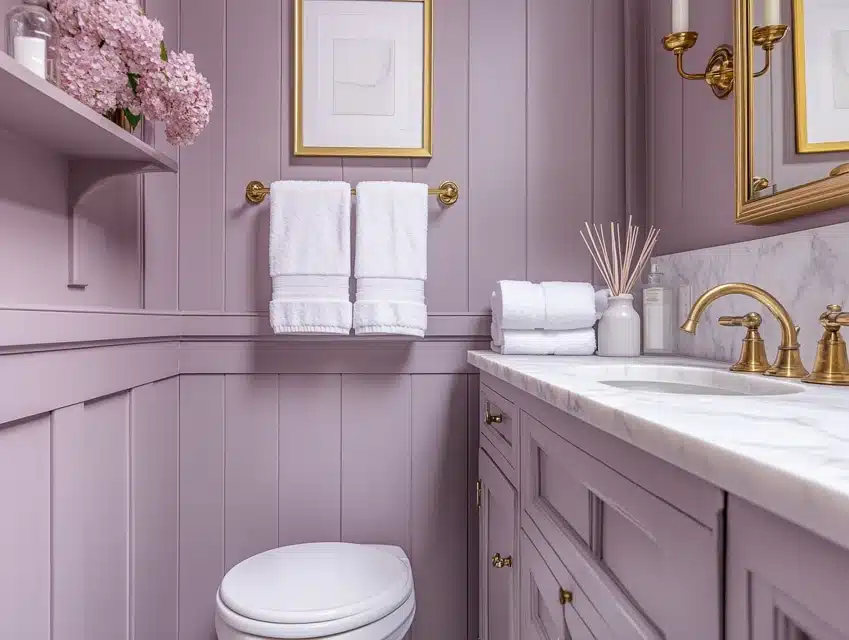
Soft plum is a subdued purple that offers a rich, luxurious feel to small bathrooms without overwhelming the space.
It’s sophisticated yet calming, perfect for creating a spa-like retreat.
To me, it’s like the perfect balance between drama and elegance.
Why I Love It
- Soft plum adds a unique pop of color while remaining understated.
- It pairs beautifully with metallics like silver and gold.
- The muted tone creates a calming, serene atmosphere.
How to Style It
- Pair it with light gray or white fixtures for contrast.
- Add gold or brass hardware for a luxurious touch.
- Incorporate soft white towels and a plush bath mat for added comfort.
My Personal Experience
- I used soft plum in a client’s bathroom, and it became their favorite room in the house. The color added depth and elegance without making the space feel dark.
- It’s a great choice for anyone who wants something different from the usual neutrals.
- Personally, I love pairing it with textured tiles or subtle patterns for added visual interest.
35. Chalk White
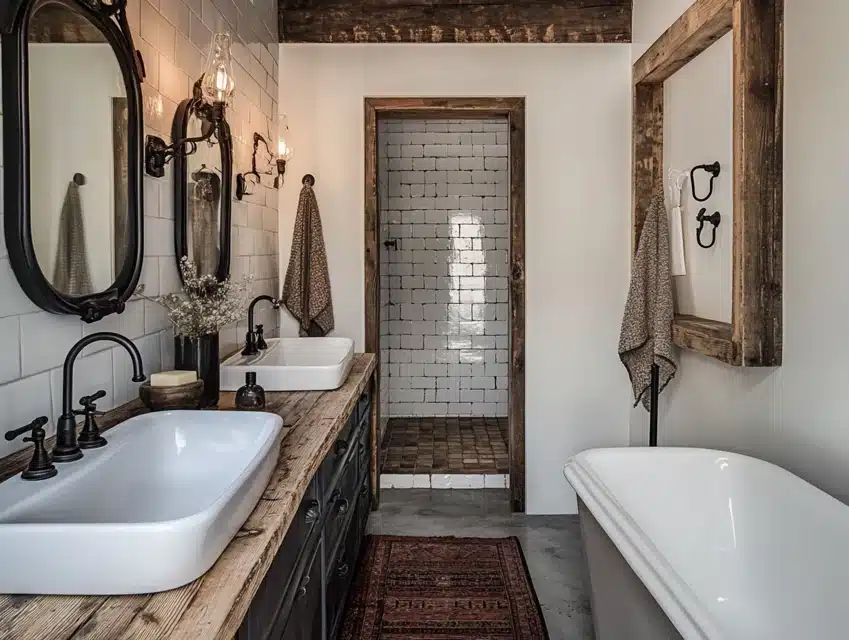
Chalk white is a matte white with a subtle texture that’s perfect for rustic or farmhouse-inspired bathrooms.
It’s simple, understated, and incredibly versatile.
To me, it’s the kind of shade that feels both fresh and timeless.
Why I Love It
- Chalk white creates a clean, bright backdrop that enhances small spaces.
- The matte finish adds a soft, cozy feel.
- It pairs beautifully with both modern and traditional decor styles.
How to Style It
- Combine it with black or bronze hardware for a classic farmhouse look.
- Add wooden accents, like a vanity or shelving, for warmth.
- Use patterned tiles or vintage mirrors to create visual interest.
My Personal Experience
- I recently painted my own bathroom in chalk white, and it transformed the space. The matte finish made the room feel cozy and inviting.
- It’s one of those colors that works in any lighting, from bright natural light to dim artificial light.
- Personally, I love how it provides a neutral canvas that lets decorative accents shine.
Conclusion
Your bathroom may be the smallest room in your home, but it doesn’t have to feel cramped or uninspiring.
The paint colors we’ve explored here offer endless possibilities for creating a stylish, spacious, and inviting space.
From the calming blues to the earthy greens and warm neutrals, each color brings something unique to the table.
Remember to consider your lighting, fixtures, and personal style when making your choice.
And don’t forget—paint is one of the easiest and most affordable ways to refresh a space.
So, go ahead and experiment with confidence.
With a little planning and the right color, your small bathroom can become a true standout in your home.
Frequently Asked Questions
What Is the Best Paint Finish for a Small Bathroom?
For bathrooms, it’s best to use a satin or semi-gloss finish.
These finishes are moisture-resistant and easier to clean, ideal for high-humidity areas like bathrooms.
Satin offers a softer look, while semi-gloss adds a bit more shine and durability.
How Do I Choose a Paint Color that Works with My Bathroom’s Lighting?
Take your bathroom’s lighting into account when choosing a color.
For bathrooms with little natural light, opt for lighter, brighter shades like soft whites or pale blues to reflect light.
If your bathroom gets ample natural light, you can experiment with slightly darker or bolder colors.
Always test a sample in your actual bathroom lighting before committing.
Can Darker Colors Work in Small Bathrooms?
Yes, darker colors can work beautifully in small bathrooms, but they require careful styling.
Pair them with light-colored fixtures, mirrors, and proper lighting to avoid making the space feel closed in.
For example, smoky gray or deep teal can create a dramatic and sophisticated look if balanced with white tiles or bright accessories.

